RMS Andania Archival Collection
RMS Andania Content Links
- Andania (1913) Cunard Line Ship's History (Brief)
- Andania (1922) Cunard Line Ship's History (Brief)
- Passenger Lists
- Brochures
- Menus
- Title Pages
- Sailing Schedules
- Back Cover Images
- Route Maps, Track Charts, Abstract of Logs
- Passage Rates
- Other Ephemera
- Excerpts from Information for Passengers
- Photographs
- Books
- The Sinking of the SS Andania, 1918
- New Cunarder Successfully Launched - 1921
- The Andania Public Rooms Architecture - 1922
Return to Content Links
Andania (1913) Cunard Line
Built by Scott's Shipbuilding & Engineering Co., Greenock, Scotland. Tonnage: 13,404. Dimensions: 520' x 64' (540 'o.l.). Propulsion: Twin-screw, 16 knots. 2 x 4-cylinder Quadruple expansion engines. Masts and Funnels: Two masts and two funnels. Type: Passenger-cargo ship. Passengers: 520 second-class and 1,540 third-class passengers. Maiden voyage: England- Canada, 14 July 1913. Fate: Torpedoed and sunk near Rathlin Light, January 27,. 1918, with the loss of seven lives. Sister ship: Alaunia. Comments: First Cunard liners designed for the Canadian service. War Service: The Andania, Ascania, Ivernia, and Saxonia were used as prison ships for several months in 1915, each providing accommodation for nearly 2,000 German prisoners. Afterward, they were employed as Transports to India and the Mediterranean. In the end, the Ivernia, Ascania, and Andania were all sunk by enemy submarines. These losses represented a heavy sacrifice by the Company, particularly given the post-war navigation needs.
Andanía (1922) Cunard Line
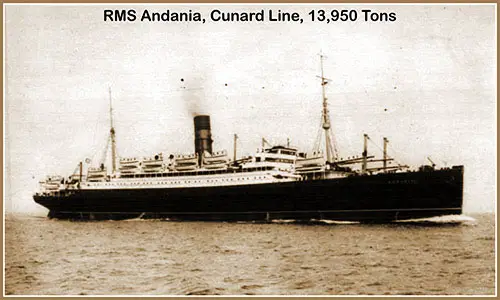
RMS Andania of the Cunard Line, 13,950 Tons
Built by R. & W. Hawthorn, Leslie & Co., Newcastle, England. Tonnage: 13,950. Dimensions: 520' x 65' (540' o.l.). Propulsion: Twin-screw, 15 knots. Double Reduction Steam Turbines, 2 Shafts. Masts and Funnels: Two masts and one funnel. Passengers: 500 cabin, 1,200 third. Maiden Voyage: 1 June 1922. Class and Type: "A"-Class Ocean Liner. Modifications: Converted to British armed merchant cruiser in 1939. Fate: Torpedoed and sunk near Iceland, June 15, 1940. Sister ships: Antonia and Ausonia. Similar ships: Alaunia, Ascania and Aurania. Note: All were built for the Canadian trade.
Return to Content Links
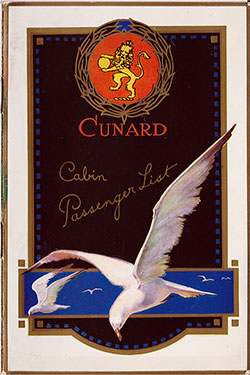
RMS Andania Passenger Lists 1923-1928
Digitized lists of passengers for the RMS Andania are available in the GG Archives. Listing Includes the Date the Voyage Began, Steamship Line, Vessel, Passenger Class, and Route.
Routes: Routes: Southampton to Quebec & Montreal via Cherbourg & Queenstown (Cobh); Hamburg to Halifax NS and New York via Southampton, Cherbourg, and Queenstown (Cobh); and Liverpool to Québec and Montréal via Greenock and Belfast.
Return to Content Links

Cunard Tourist Third Cabin Accommodations - 1920s
Tourist Third Cabin replaced the old Third Class on the Cunard Steamships. The refinished accommodations attracted students, professors, young business people, and bargain-hunters, filling the cabins left mostly empty from the decline of the immigrant trade. This is a photo journal of the accommodations found in the new Tourist Third Cabin class.
Ships Featured: Andania, Antonia, Aquitania, Ascania, Aurania, Ausonia, Berengaria, Caronia and Carmania, Laconia, Samaria, Scythia, Tuscania, and Lancastria.
Return to Content Links
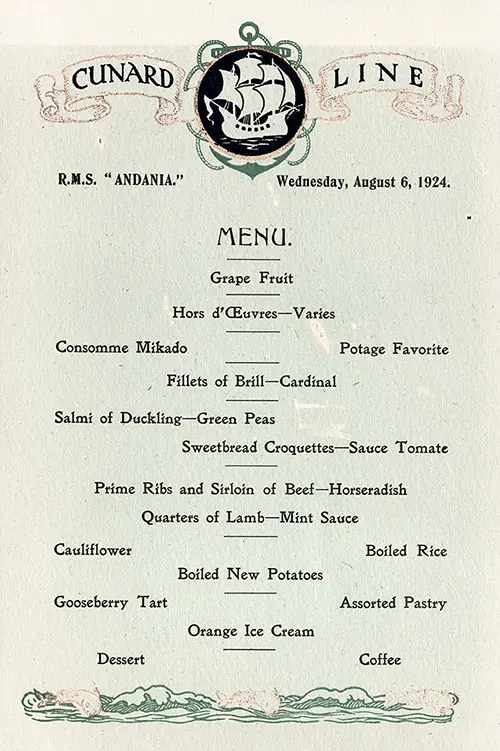
1924-08-06 RMS Andania Dinner Menu Card
A Vintage Dinner Menu Card from 6 August 1924 on board the RMS Andania of the Cunard Line featured Fillets of Brill—Cardinal, Salmi of Duckling—Green Peas, Prime Ribs, and Sirloin of Beef—Horseradish.
Return to Content Links
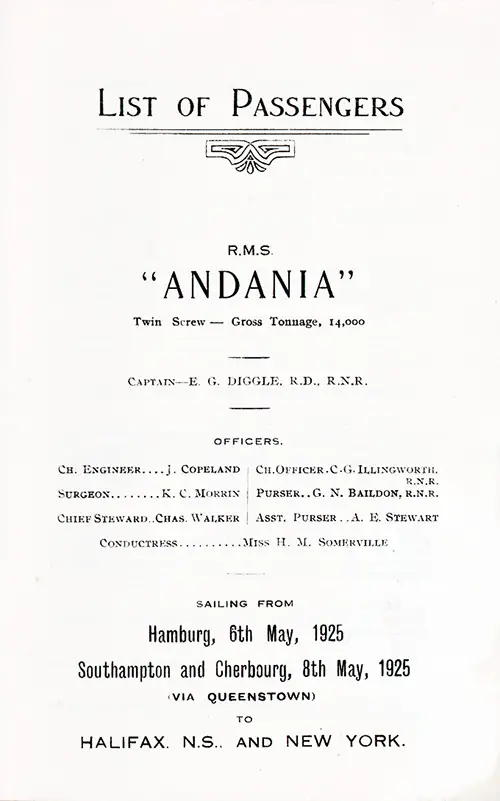
Title Page, SS Andania Cabin Passenger List, 6 May 1925, Hamburg to Halifax and New York via Southampton, Cherbourg, and Queenstown. Contains Listing of Senior Officers. | GGA Image ID # 1f8e9b2857
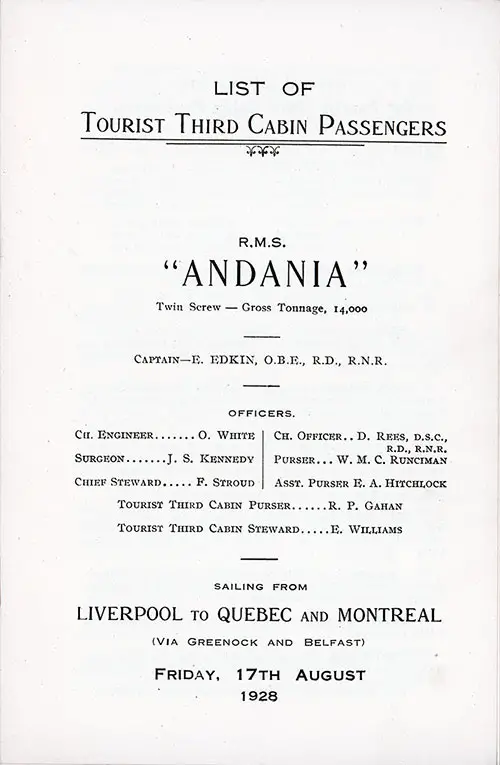
Title Page, including List of Senior Officers, RMS Andania Tourist Third Cabin Passenger List, Friday, 17 August 1928, Sailing from Liverpool to Québec and Montréal via Greenock and Belfast. | GGA Image ID # 1f8f17637a
Return to Content Links
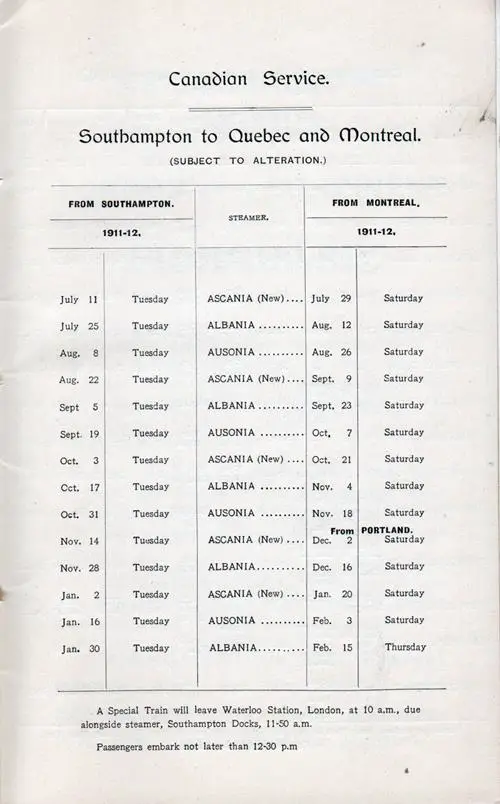
Sailing Schedule, Cunard Canadian Service. Southampton to Québec and Montréal Sailing Schedule from 11 July 1911 to 15 February 1912. Ships Include the Ascania, Albania, and Ausonia. | GGA Image ID # 1db7311adf
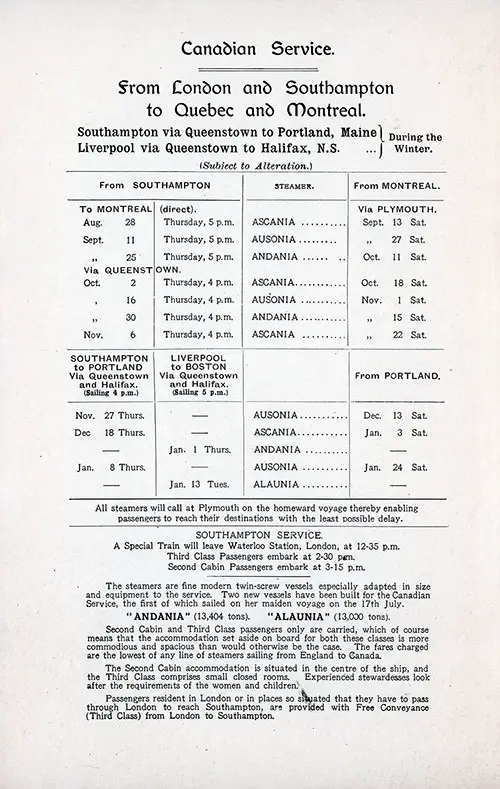
Sailing Schedule, Cunard Canadian Service from 26 August 1913 to 24 January 1914. Ships Included the Alaunia, Andania, Ascania, and Ausonia. RMS Carmania Passenger List, 23 September 1913. | GGA Image ID # 1dcaed5b2e
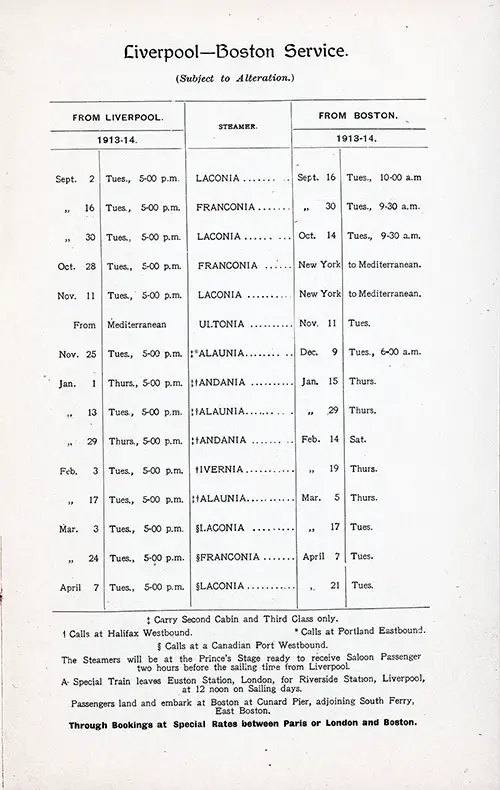
Sailing Schedule, Cunard Liverpool-Boston Service from 2 September 1913 to 21 April 1914. Ships Included the Alaunia, Andania, Francoia, Ivernia, Laconia, and Ultonia. RMS Carmania Passenger List, 23 September 1913. | GGA Image ID # 1dcaaf02a5
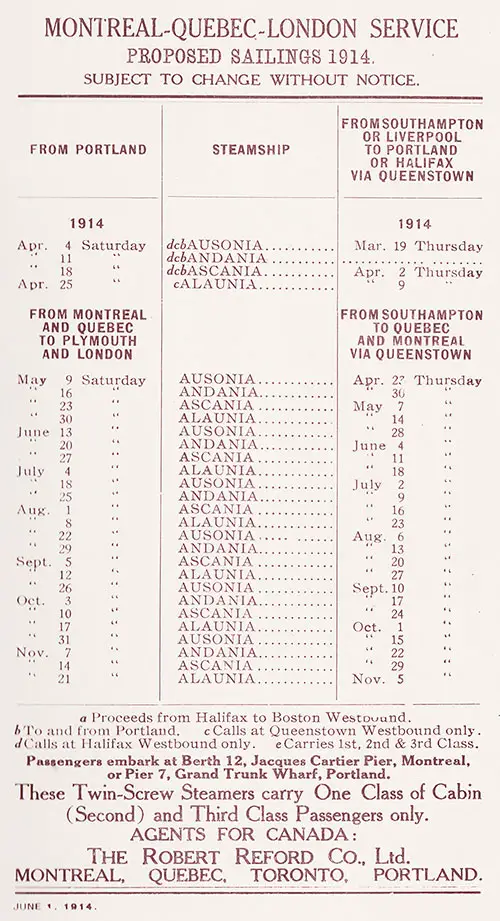
Sailing Schedule, Montréal-Québec-London Service, from 4 April 1914 to 21 November 1914. Ships Included the Alaunia, Andania, Ascania, and Ausonia. Cunard Line Service 1914 Brochure. | GGA Image ID # 1f7b279b85
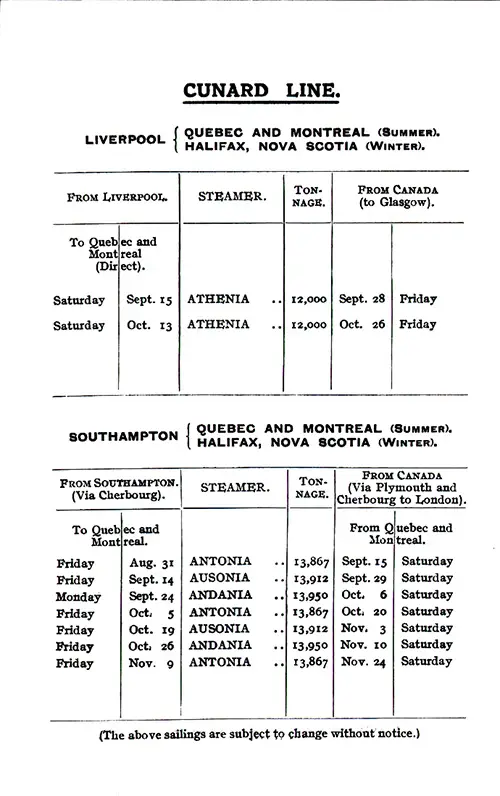
Sailing Schedule, Liverpool or Southampton to Canadian Ports, from 15 September 1923 to 24 November 1923. Ships Included the Andania, Antonia, Athenia, and Ausonia. RMS Berengaria Passenger List, 15 September 1923. | GGA Image ID # 215c61ac4e
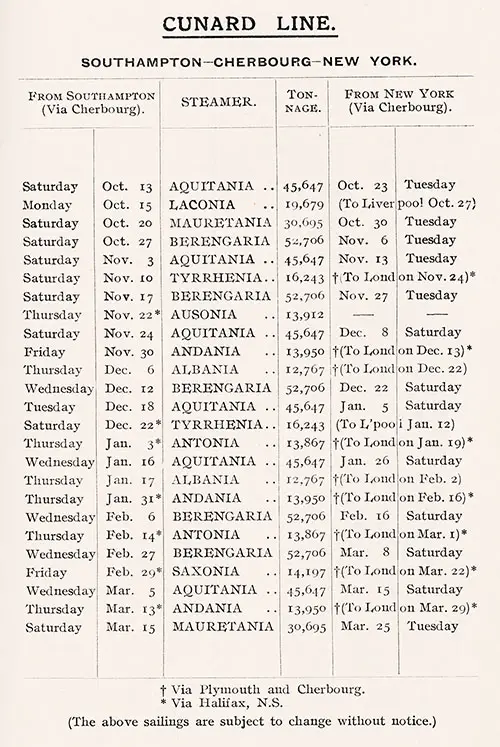
Sailing Schedule, Southampton-Cherbourg-New York, from 13 October 1923 to 25 March 1924. Ships Included the Albania, Andania, Antonia, Aquitania, Ausonia, Berengaria, Laconia, Mauretania, Saxonia, and Tyrrhenia. RMS Samaria Passenger List, 22 October 1923. | GGA Image ID # 1f19fa1211
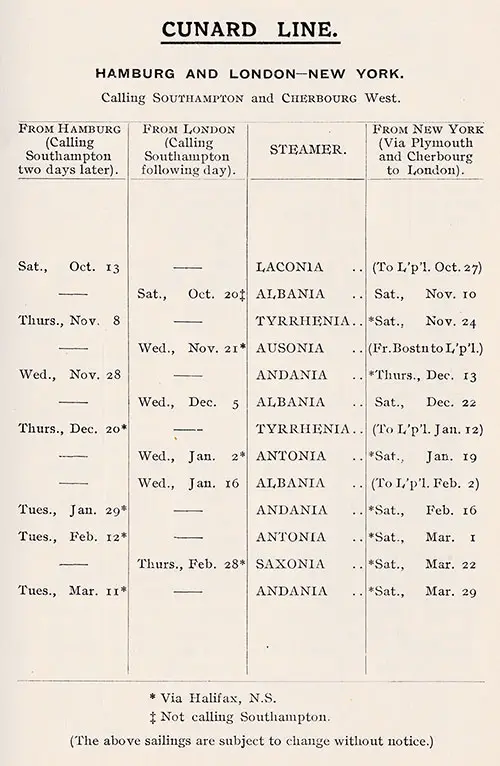
Sailing Schedule, Hamburg-London-Southampton-New York and New York-Plymouth-Cherbourg-London-Hamburg, from 13 October 1923 to 29 March 1924. Ships Included the Albania, Andania, Antonia, Ausonia, Laconia, Saxonia, and Tyrrhenia. RMS Samaria Passenger List, 22 October 1923. | GGA Image ID # 1f19beaa99
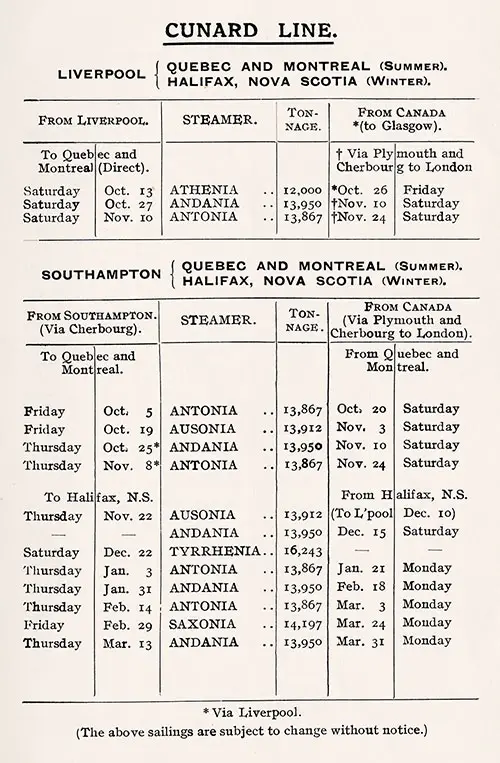
Sailing Schedule, Liverpool or Southampton to Canadian Ports, From 5 October 1923 to 31 March 1924. Ships Included the Andania, Antonia, Ausonia, Saxonia, and Tyrrhenia. RMS Samaria Passenger List 22 October 1923. | GGA Image ID # 1f1a16b630

Sailing Schedule, Liverpool or Southampton to Canadian Ports, from 9 May 1924 to 15 November 1924. Ships Included the Andania, Antonia, Athenia, Ausonia, Carmania, and Caronia. RMS Berengaria Passenger List, 24 May 1924. | GGA Image ID # 215c748813
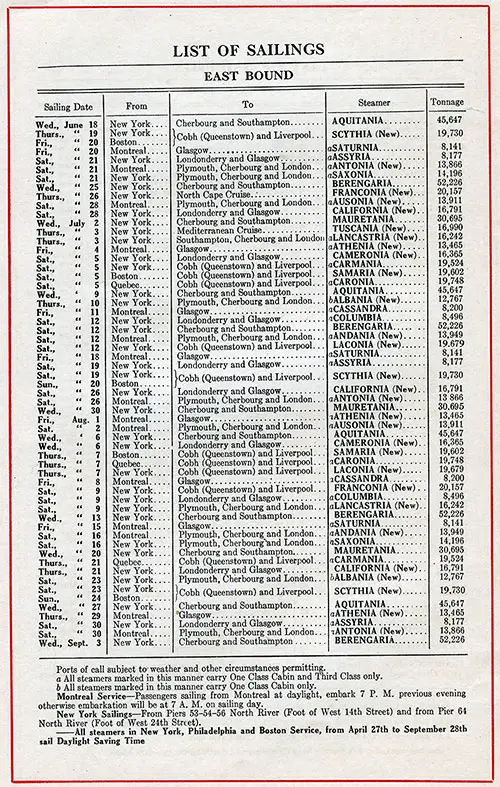
Eastbound Sailing Schedule from the US and Canadian Ports to European Ports, from 18 June 1924 to 3 September 1924. Ships Included the Albania, Andania, Antonia, Aquitania, Assyria, Athenia, Ausonia, Berengaria, California, Cameronia, Carmania, Caronia, Cassandra, Columbia, Franconia, Laconia, Lancastria, Mauretania, Samaria, Saturnia, Saxonia, Scythia, and Tuscania. RMS Aquitania Second Class Passenger List, 18 June 1924. | GGA Image ID # 20aea275f3
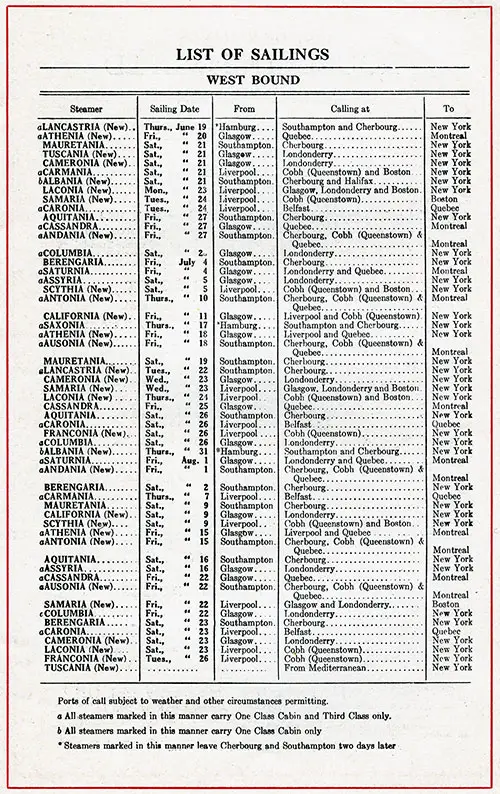
Westbound Sailing Schedule, from European Ports to Canadian and US Ports, from 19 June 1924 to 26 August 1924. Ships Included the Albania, Andania, Antonia, Aquitania, Assyria, Athenia, Ausonia, Berengaria, California, Cameronia, Carmania, Caronia, Cassandra, Columbia, Franconia, Laconia, Lancastria, Mauretania, Samaria, Saturnia, Saxonia, Scythia, and Tuscania. RMS Aquitania Second Class Passenger List, 18 June 1924. | GGA Image ID # 20aeac371f
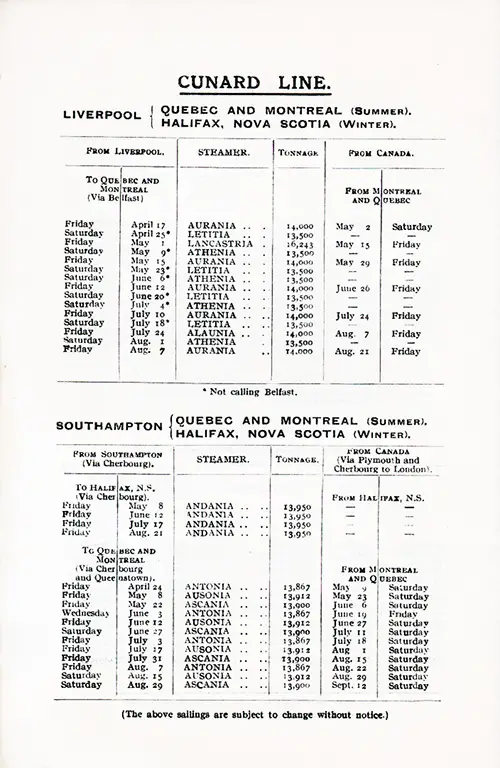
Sailing Schedule, Liverpool-Québec-Montréal, Liverpool-Halifax, Southampton-Québec-Montréal, and Southampton-Halifax, from 17 April 1925 to 12 September 1925. Ships included the Alaunia, Andania, Antonia, Ascania, Athenia, Aurania, Ausonia, Lancastria, and Letitia. RMS Andania Passenger List, 6 May 1925. | GGA Image ID # 1e1063298c
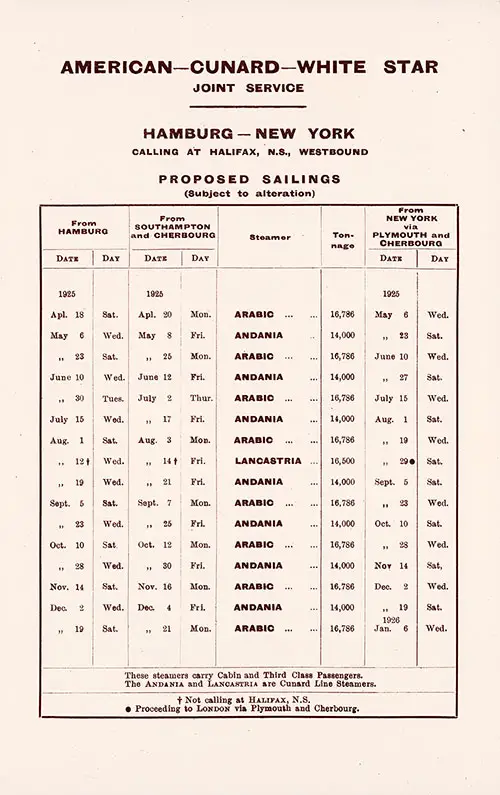
Sailing Schedule, American-Cunard-White Star Joint Service, Hamburg-New York, from 18 April 1925 to 6 January 1926. Ships Included the Andania, Arabic, and Lancastria. RMS Celtic Passenger List, 30 May 1925. | GGA Image ID # 1e53f619be
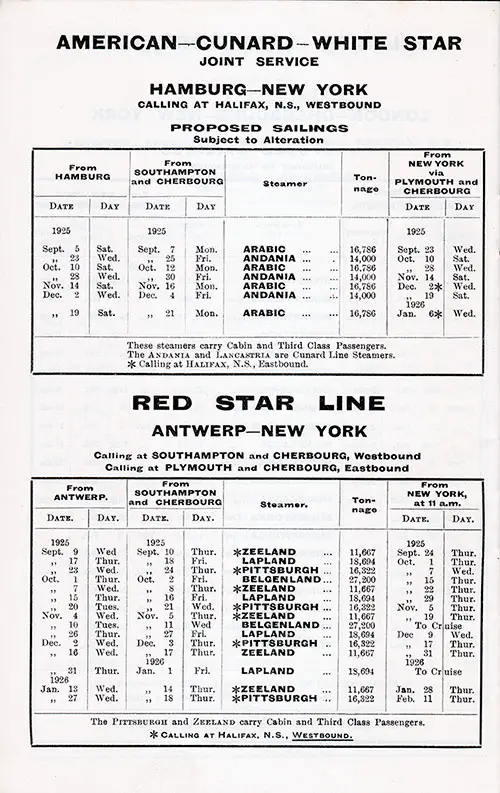
Sailing Schedule, American — Cunard — White Star Joint Service, Hamburg-New York Calling at Halifax (Westbound) and Red Star Line Antwerp-New York via Southampton and Cherbourg (Westbound) and Plymouth and Cherbourg (Eastbound). Proposed Sailings from 5 September 1925 to 11 February 1926. Joint Service Ships Included the Arabic and Andania: Steamers Carry Cabin and Third Class Passengers. The Andania and Lancastria are Cunard Line Steamers. Red Star Line Ships Included the Zeeland, Lapland, Pittsburgh, and Belgenland—the Pittsburgh and Zeeland Carry Cabin and Third Class Passengers. | GGA Image ID # 1db51d14f1
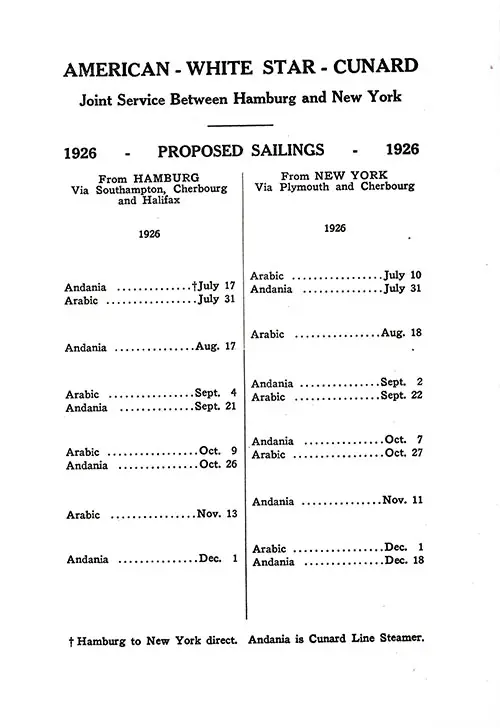
Sailing Schedule, American Line, White Star Line, Cunard Line, Joint Service Between Hamburg and New York, from 10 July 1926 to 18 December 1926. Ships Included the Andania and Arabic. RMS Belgenland Passenger List, 26 June 1926. | GGA Image ID # 1df2f57889
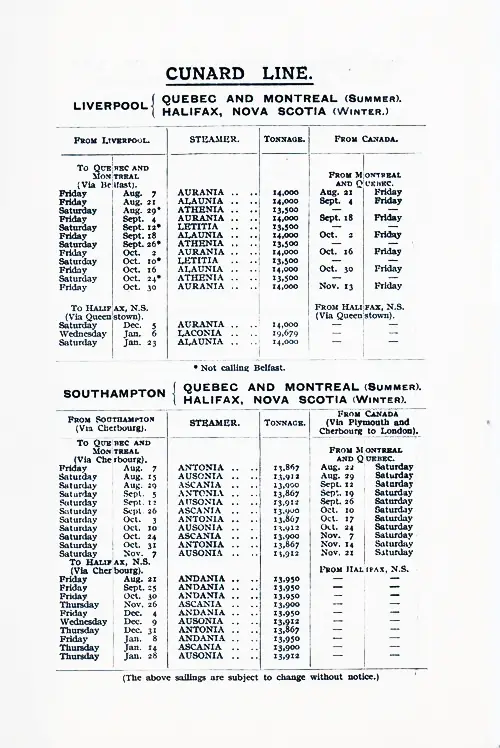
Sailing Schedule, Cunard Line Canadian Service, Liverpool-Canadian Ports, or Southampton to Canadian Ports, from 7 August 1925 to 28 January 1926. Ships Included the Alaunia, Andania, Antonia, Ascania, Athenia, Aurania, Ausonia, Laconia, and Letitia. RMS Alaunia Passenger List, 21 August 1925. | GGA Image ID # 1dff527901
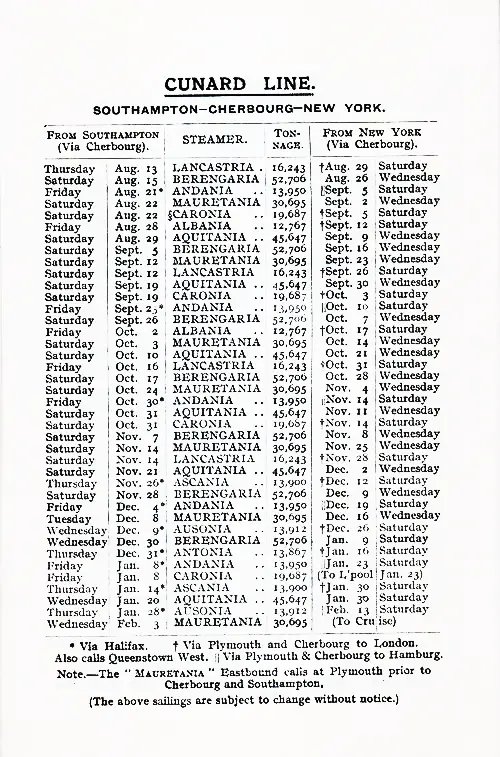
Sailing Schedule, Cunard Line, Southampton-Cherbourg-New York, from 13 August 1925 to 3 February 1926. Ships Included the Albania, Andania, Aquitania, Ascania, Ausonia, Berengaria, Caronia, Lancastria, and Mauretania. RMS Alaunia Passenger List, 21 August 1925. | GGA Image ID # 1dfef4697b
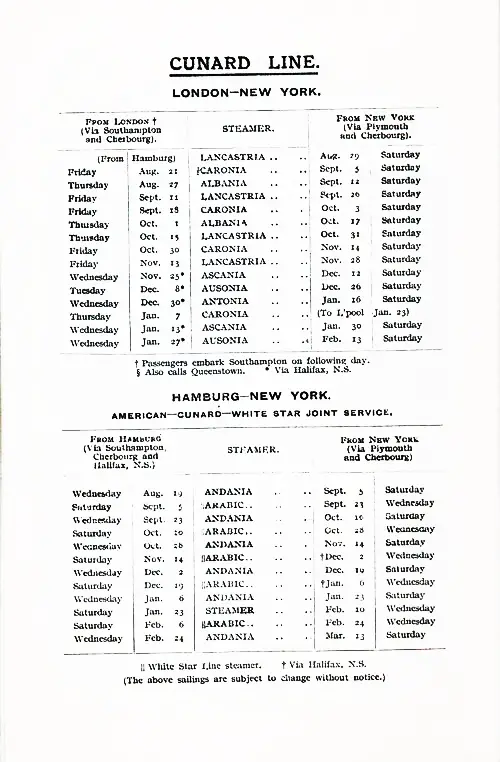
Sailing Schedule, Cunard Line, London-New York, and Hamburg-New York (Joint Service Between American Line, Cunard, and White Star Line). from 19 August 1925 to 13 March 1926. Ships Included the Albania, Andania, Antonia, Arabic, Ascania, Ausonia, Caronia, and Lancastria. RMS Alaunia Passenger List, 21 August 1925. | GGA Image ID # 1dff49d2fd
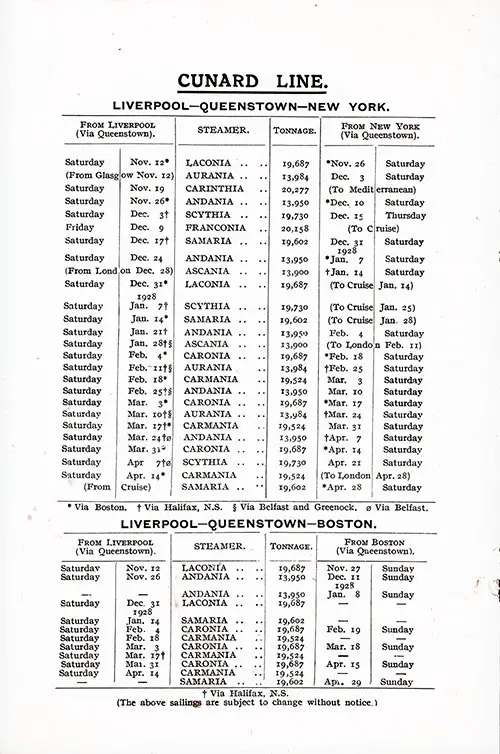
Sailing Schedule, Liverpool, Cobh (Queenstown)-New York-Boston, from 12 November 1927 to 29 April 1928. Ships Included the Andania, Aurania, Carinthia, Carmania, Caronia, Franconia, Laconia, Samaria, and Scythia. RMS Aquitania Passenger List, 26 November 1927. | GGA Image ID # 1e119dff3d
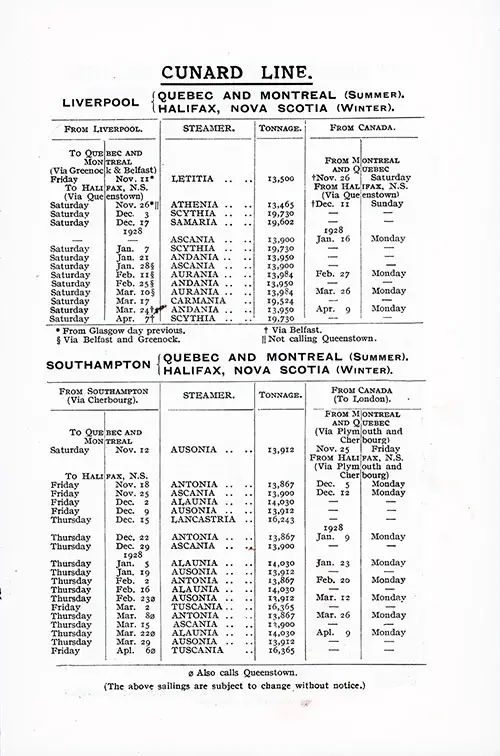
Sailing Schedule, Liverpool-Canadian Ports, from 11 November 1927 to 9 April 1928. Ships Included the Alaunia, Andania, Antonia, Ascania, Athenia, Ausonia, Carmania, Lancastria, Letitia, Samaria, Scythia, and Tuscania. RMS Aquitania Passenger List, 26 November 1927. | GGA Image ID # 1e11e04456

Sailing Schedule, Liverpool-Canadian Ports, from 11 November 1927 to 9 April 1928. Ships Included the Alaunia, Andania, Antonia, Ascania, Athenia, Ausonia, Carmania, Lancastria, Letitia, Samaria, Scythia, and Tuscania. RMS Aquitania Passenger List, 26 November 1927. | GGA Image ID # 1e11e04456
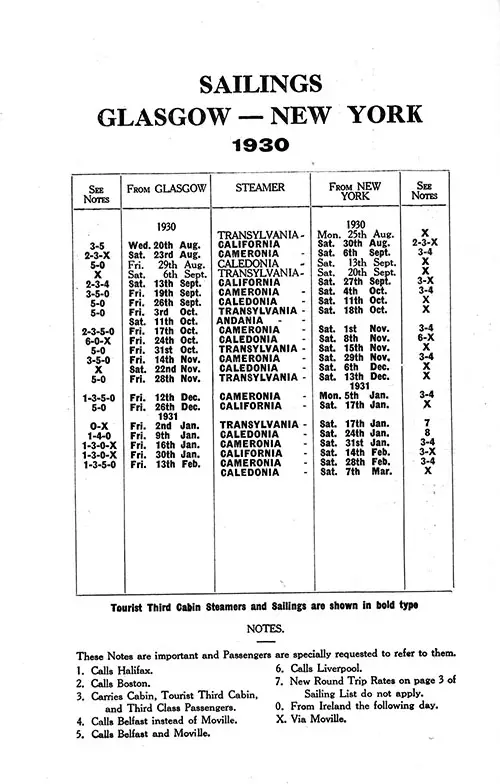
Sailing Schedule, Glasgow-New York, from 25 August 1930 to 13 February 1931. Ships Included the Andania, Caledonia, California, Cameronia, and Transylvania. SS California Passenger List, 20 August 1930. | GGA Image ID # 1e39b3e994
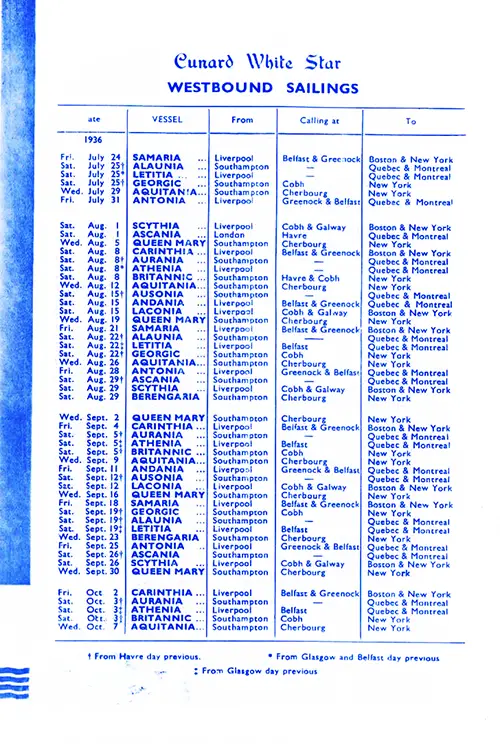
Westbound Sailing Schedule, from Liverpool or Southampton to Boston, New York, Québec, or Montréal via Belfast, Cherbourg, Greenock, Galway, or Le Havre, from 24 July 1936 to 7 October 1936. Ships Included the Alaunia, Andania, Antonia, Aquitania, Ascania, Athenia, Aurania, Ausonia, Berengaria, Britannic, Carinthia, Georgic, Laconia, Letitia, Queen Mary, Samaria, and Scythia. RMS Samaria Passenger List, 24 July 1936. | GGA Image ID # 1eccbb8952
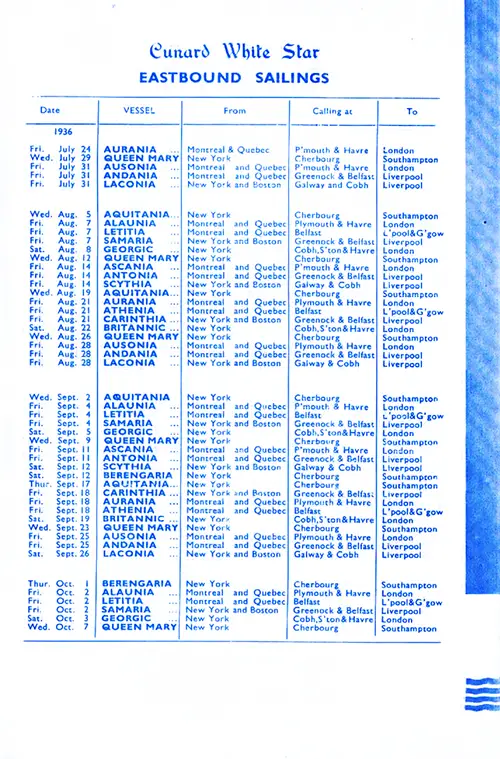
Eastbound Sailing Schedule, from Boston, New York, Québec, or Montréal to Glasgow, Liverpool, London, or Southampton via Belfast, Cherbourg, Cobh, Galway, Greenock, Le Havre, or Plymouth, from 24 July 1936 to 7 October 1936. Ships Included the Alaunia, Andania, Antonia, Aquitania, Ascania, Athenia, Aurania, Ausonia, Berengaria, Britannic, Carinthia, Georgic, Laconia, Letitia, Queen Mary, Samaria, and Scythia. RMS Samaria Passenger List, 24 July 1936. | GGA Image ID # 1ecd389488
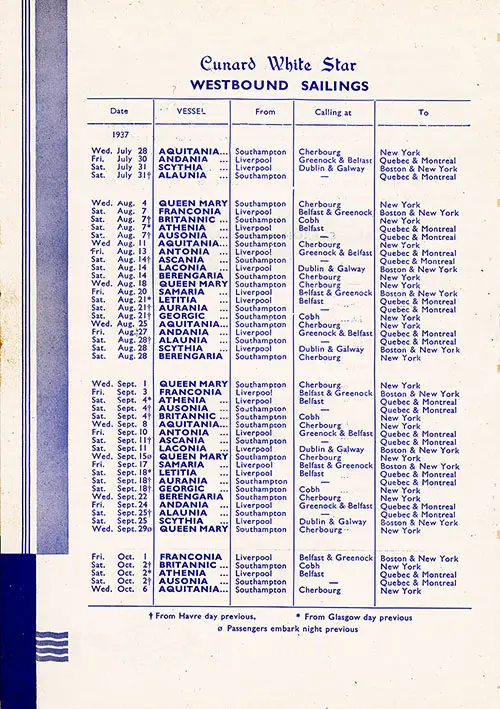
Westbound Sailing Schedule, Cunard White Star Vessels, from 28 July 1937 to 6 October 1937. Ships Included the Alaunia, Andania, Antonia, Ascania, Athenia, Aquitania, Aurania, Ausonia, Berengaria, Britannic, Franconia, Georgic, Laconia, Letitia, Queen Mary, Samaria, and Scythia. RMS Aquitania Cabin Class Passenger List, 28 July 1937. | GGA Image ID # 20bfda234f
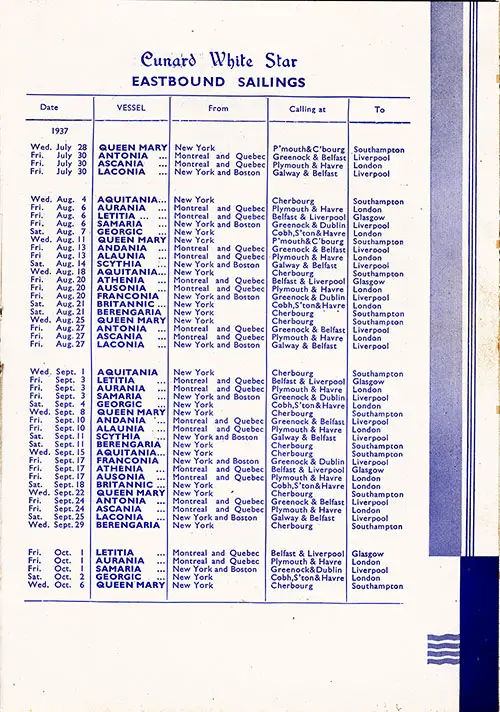
Eastbound Sailing Schedule, Cunard White Star Vessels, from 28 July 1937 to 6 October 1937. Ships Included the Alaunia, Andania, Antonia, Ascania, Athenia, Aquitania, Aurania, Ausonia, Berengaria, Britannic, Franconia, Georgic, Laconia, Letitia, Queen Mary, Samaria, and Scythia. RMS Aquitania Cabin Class Passenger List, 28 July 1937. | GGA Image ID # 20bfdeea90
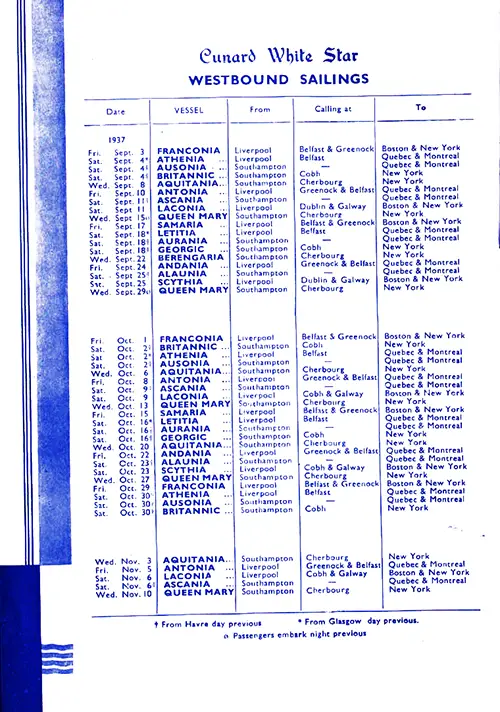
Cunard White Star Westbound Sailing Schedule for 3 September to 10 November 1937. Ships Include the Alaunia, Andania, Antonia, Aquitania, Ascania, Athenia, Aurania, Ausonia, Berengaria, Britannic, Franconia, Georgic, Laconia, Letitia, Queen Mary, Samaria, and Scythia. | GGA Image ID # 1db7e0cf97
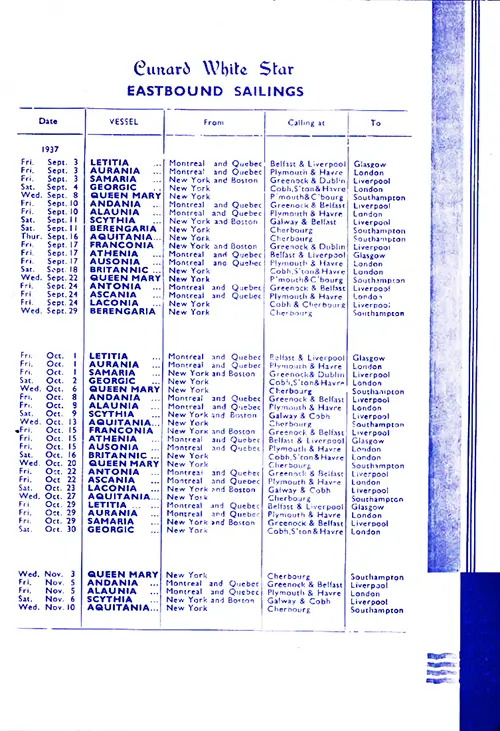
Cunard White Star Eastbound Sailing Schedule for 3 September to 10 November 1937. Ships Include the Alaunia, Andania, Antonia, Aquitania, Ascania, Athenia, Aurania, Ausonia, Berengaria, Britannic, Franconia, Georgic, Laconia, Letitia, Queen Mary, Samaria, and Scythia. | GGA Image ID # 1db80746e8
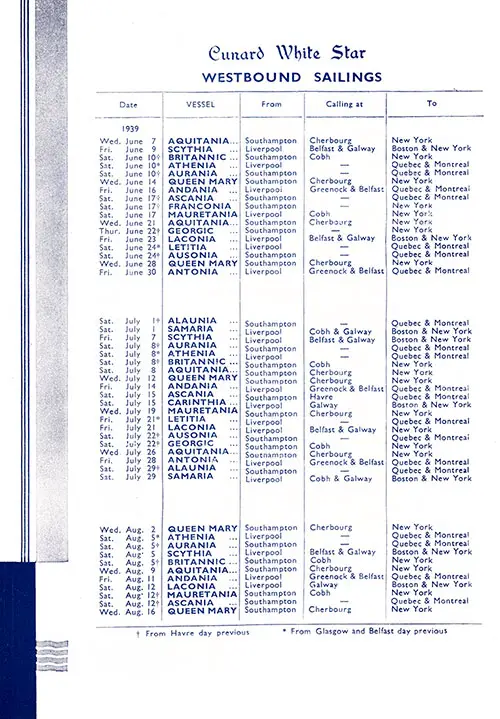
Westbound Sailing Schedule from 7 June 1939 to 16 August 1939. Ships Included the Alaunia, Andania, Antonia, Ascania, Athenia, Aquitania, Aurania, Ausonia, Britannic, Carinthia, Franconia, Georgic, Laconia, Letitia, Mauretania, Queen Mary, Samaria, and Scythia. RMS Aquitania Passenger List, 7 June 1939. | GGA Image ID # 1e141a92c5
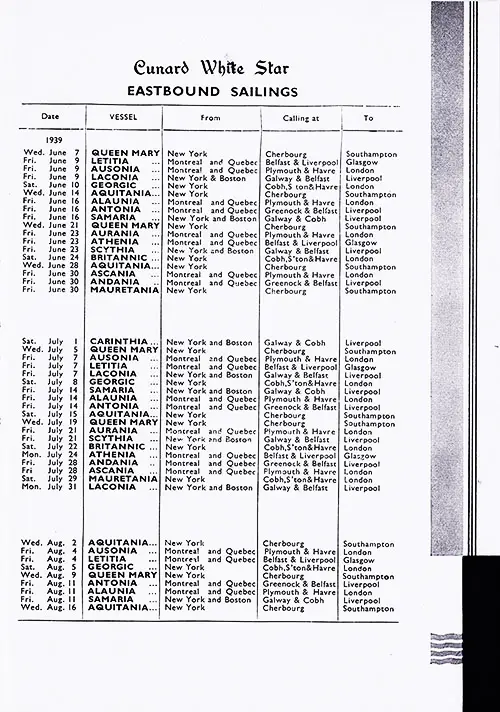
Eastbound Sailing Schedule from 7 June 1939 to 16 August 1939. Ships Included the Alaunia, Andania, Antonia, Aquitania, Ascania, Athenia, Aurania, Ausonia, Britannic, Carinthia, Georgic, Laconia, Letitia, Mauretania, Queen Mary, Samaria, and Scythia. RMS Aquitania Passenger List, 7 June 1939. | GGA Image ID # 1e1424c50b
Return to Content Links
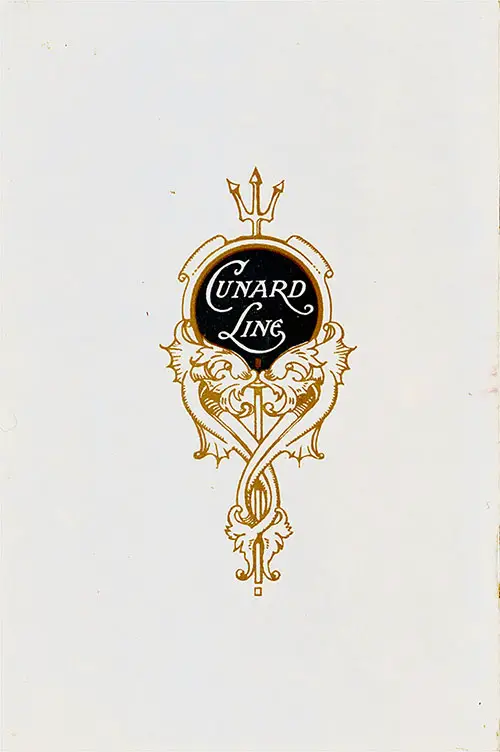
Back Cover of a Cabin Passenger List from the RMS Andania of the Cunard Line, Departing Friday, 8 June 1923 from Southampton to Québec and Montréal via Cherbourg. | GGA Image ID # 122404c6d4

Back Cover of a Cabin Passenger List from the RMS Andania of the Cunard Line, Departing Friday, 1 August 1924 from Southampton to Québec and Montréal via Cherbourg and Queenstown (Cobh). | GGA Image ID # 12820967aa
Return to Content Links
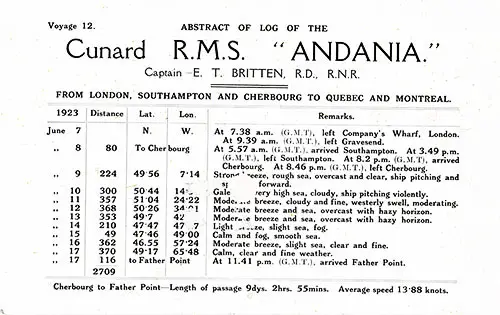
Abstract of Log, RMS Andania, from London to Québec and Montréal via Southampton and Cherbourg, 7 June 1923. Commander: Captain E. T. Britten, R.D., RNR. Cherbourg to Father Point -- Length of Passage 9 Days, 2 Hours, 55 Minutes. Average Speed 13.88 Knots. | GGA Image ID # 1f8e9a6f35
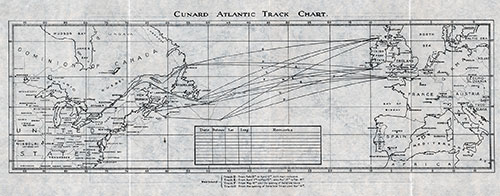
Cunard Atlantic Track Chart, Unused, RMS Andania Tourist Third Cabin Passenger List, 17 August 1928. | GGA Image ID # 1610cdd10c
Return to Content Links
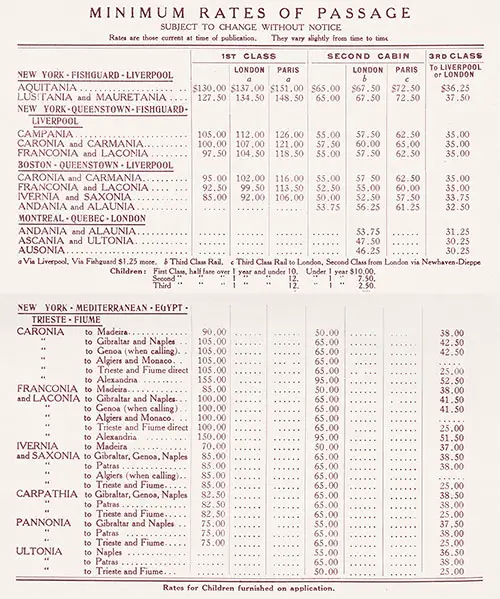
Minimum Rates of Passage, First Class, Second Cabin, or Third Class. Ships Included the Aquitania, Lusitania, Maruetania, Campania, Caronia, Carmania, Franconia, Laconia, Ivernia, Saxonia, Andania, Alaunia, Ascania, Ultonia, Ausonia, Carpathia, and Pannonia. Cunard Line Services 1914 Brochure. | GGA Image ID # 1f7949ddf9
Return to Content Links
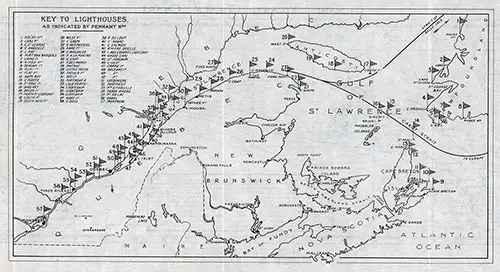
Key to Canadian Lighthouses, Cunard Line, 1928. | GGA Image ID # 1610df744a
Return to Content Links
Information for Passengers - 8 June 1923
The Bars in the Cabin will not be open later than 11:00 pm., but it is within the discretion of the Commander to close them during the voyage at any time should he considers this course desirable.
SEATS AT TABLE.—Application may be made at any of the Chief Offices in advance, or to the Second Steward on board the Steamer on day of sailing.
DIVINE SERVICE on Sunday at 10:30 am
ARRIVALS AT QUÉBEC AND MONTRÉAL. — Examination of Saloon, Cabin and Second Class passengers takes place at Québec or on board steamer between Québec and Montréal.
On arrival at Montréal the Customs are in attendance at the Dock, together with Representatives of the Railway Companies, and passengers destined to interior points holding rail orders, exchange such orders for actual Rail tickets, pass the Customs and check their baggage through to destination.
Passengers are transferred in the Transfer Company’s vehicles from the Dock to the Railway Stations,
In the event of the steamer docking at Montréal too late in the evening for passengers to make connections with the night trains, they may remain on board overnight and disembark at 7.00 a.m. next morning.
ARRIVALS AT HALIFAX.—Immigration regulations at the port of Halifax will not permit of passengers being examined after dark that is, after 5.00 p.m. in the winter time and 7:00 pm. in the summer. Steamers dock at Pier Two, Government Piers, at any hour.
If there are sufficient numbers, a special train is dispatched from alongside steamer as soon as possible after landing of passengers for Montréal and West. If there is no special, passengers leave on the regular trains.
Baggage is checked by the passengers when they come off the steamer and loaded by railway officials into baggage cars, free of charge.
DOGS.—Passengers are notified that dogs cannot be landed In Great Britain unless a license has previously been procured from the Board of Agriculture, London. Forms of license must be obtained by direct application to the Department before the dog is taken on board. Dogs are carried at owner's risk, rate being from £3 upwards, payable to the Purser.
VALUABLES.—The Company is not responsible for theft if valuables or money are kept in the Staterooms. The same should be placed in charge of the Purser for deposit in his safe, and a receipt will be given on the Company’s form. As no charge is made for carriage the Company cannot accept any responsibility for loss or damage, however arising, but passengers can protect themselves by insurance.
PAYMENTS.—Passengers should obtain a receipt from the Purser on the Company's form for any additional Passage Money, Rugs. Chairs, Excess Baggage, Freight, etc., paid on board.
MONEY EXCHANGE.—As a convenience to passengers the Purser has been authorized to carry fluids for Exchange purposes, but owing to fluctuations it is not possible to make any fixed Rate of Exchange.
THE SURGEON is authorized to make customary charges, subject to the approval of the Commander, for treating any passengers at their request for any illness not originating on board the ship. In the case of sickness contracted on board no charge will be made and medicine will be provided free.
BARBER.—The Barber's Shop is situated on "B” Deck.
LIBRARIES.—In addition to a library of Standard Works, a special selection of up-to-date literature is available for the use of passengers.
ARRIVALS AT CHERBOURG.—Under normal conditions passengers are landöl by tender up to 10:00 pm, but if the ship arrives later, they will disembark after breakfast next morning.
ARRIVALS AT PLYMOUTH.—Passengers are lauded at any time of the day or night. A special train will be dispatched to London providing the number of passengers warrant same.
Should the numbers not be sufficient for a special train, arrangements can, if necessary, be made at Plymouth to accommodate passengers overnight. Passengers so remaining at Plymouth can travel by first train the next day, leaving at 8:30 am
ARRIVALS AT SOUTHAMPTON. – Passengers will be landed up to 8:00 pm If the ship berths later passengers will disembark next morning after breakfast.
A Special Train will be dispatched to London (Waterloo Station) as soon as possible after landing, the journey occupying a 1 ¾ hours. Passengers are strongly recommended to purchase their rail tickets between Southampton and London at the Purser's Office on board, as failure to do this may result in delay and inconvenience to the passenger.
It is notified for the information of passengers that the Cunard Company employ at Southampton the necessary labor for transfer of baggage from the steamer to the special trains at the ship's aide for London.
Passengers on arrival will find representatives of well- known firms in the shed alongside the steamer, and if their special «ervices are utilized for the handling of baggage they are authorized to charge according to tariff.
ARRIVALS AT LIVERPOOL — TIME OF LANDING PASSENGERS.—Under normal conditions when any of the Company’s steamers arrive alongside the Liverpool Landing Stage after 7:00 pm. it is optional for the passengers to go on shore that night. In the event, however, of their remaining on board, they will be landed after breakfast the following morning either at the Stage or in dock as circumstances permit.
In the same way when the vessel reaches the river, but does not come alongside the Stage, to prevent inconvenience and to meet emergencies, any passengers desirous of disembarking will on arrival of the steamer, be landed, with hand baggage only, by tender.
BAGGAGE. — Westbound passengers proceeding from London to Southampton by special trains will pay to the Southern Railway at Waterloo Station, London, any ocean excess baggage charges due.
Passengers are recommended to insure their Baggage, as the Company’s liability is strictly limited in accordance with Contract Ticket. All enquiries regarding Baggage on board ship should be addressed to the Baggage Master.
Passengers are specially requested to claim their baggage before leaving the Customs Baggage Room, otherwise considerable delay and extra charge for carriage will be incurred in forwarding to destination any baggage not accompanying passengers on the Railway.
CUSTOMS AND BAGGAGE. — Cunard baggage officials and Canadian Government Customs officials meet steamers on arrival and arrange examination and checking of baggage through to the rail destination.
On arrival in port, immediately after Government inspection, and tickets to inland destinations have been obtained, passengers should attend to the Customs examination of their baggage and arrange with the Railway Agent for its forwarding; the Railway Agent will issue a check for each piece of baggage to be forwarded. Unless baggage be checked out by passengers it will be held at their risk until claimed.
U.S. Customs Officers are at St. John, N.B., Québec, Montréal, Ottawa, Toronto, London, Out., Winnipeg, Man., Banff (during Summer) and Vancouver, B.C., Stations to examine baggage destined for U.S. Passengers travelling to the U.S. via these points are recommended to have baggage inspected there and avoid examination at International Boundary. Baggage to U.S. not examined at above places must be inspected at International Boundary, otherwise it will be held b}' Customs. Passengers should attend personally to Customs Examination of baggage.
POSTING LETTERS AT SEA.—The Canadian Government notify that the Postal Administration of the United kingdom and Canada have entered into an agreement whereby either British or Canadian postage stamps may be used for prepayment of correspondence posted on the high seas on board contract mail steamers between Canada and the United Kingdom, whether such correspondence be posted on the Ihmtbniiud or Westbound passage of the mail steamers.
Arrangements have been made whereby letters for passengers on board the Company’s steamers at Southampton and Liverpool can be accepted for inclusion in special bags which will be made up for the ship in London and Ports of Departure.
TOURIST DEPARTMENT.—A Department is maintained at each of the Cunard Company's American and Canadian Offices where accurate information and helpful assistance relative to travel in the United States and throughout the world is at the disposal of patrons.
CUSTOMS. — Tobacco, cigars, etc., wines, spirits and perfumery are subject to duty on being brought into the United Kingdom, and the smallest quantities should be declared to the Customs Authorities. When required, reprints of copyright Books and music will be confiscated.
BERTHING OF PASSENGERS. No alterations can be made except officially through the Purser.
BERTH LADDERS.—These may be obtained on application to Steward or Stewardess.
AUTOMOBILE TOURS IN GREAT BRITAIN. — The Cunard Company is in a position to arrange for the hire of Automobiles to passengers on arrival of their steamers at Liverpool, Plymouth, or Southampton. Programs of Tours with fixed prices for same can be obtained on application to the Pursers' or the Company’s Offices.
The Tours outlined cover the most interesting and historic places in Great Britain and offer a most enjoyable trip for persons desirous of seeing more of English rural life than is possible when travelling by rail from town to town.
AUTOMOBILE TOURS ON THE CONTINENT. — The Company’s Offices at Paris, Cherbourg and Hamburg are in a to make arrangements for the hire of Cars to meet steamers at Hamburg and Cherbourg, and take passengers on long or short Tours, or direct to their destination.
Pursers will be glad to give passengers particulars of rates of hire, and any other information that they may desire.
AEROPLANE RESERVATIONS.—Seats can also be arranged for Aeroplane Services from London or Manchester to Amsterdam, Rotterdam, Paris, Brussels, Berlin, etc., also from Cherbourg to Paris. Applications should be made to the Purser.
PROFESSIONAL GAMBLERS. — Passengers are informed that Professional Gamblers are reported as frequently crossing on Atlantic Steamers and are warned to take precautions accordingly.
The "ANDANIA” carries an orchestra of professional musicians, which will play in the Public Rooms at the following times (subject to alteration according to circumstances):
- Cabin Dining Saloon: 1.10:00 pm to 2.00 p.m
- Cabin Dining Saloon: 7:10 pm to 8.00 p.m
- Cabin Lounge (Orchestral or Dancing): 9:00 pm to 10:45 pm
Ocean letters are accepted for transmission to a vessel proceeding in an opposite direction. They will be forwarded to destination by registered post from first port of call of the vessel after reception.
Source: RMS Andania Passenger List - 8 June 1923
Information for Passengers - 1 August 1924
MEALS will be served at the following times in the Cabin Dining Saloon:
When one sitting:
- Breakfast: 8:00 am
- Luncheon: 1:00 pm
- Dinner: 7:00 pm
When two sittings:
- Breakfast from 7:30 am to 8:30 am
- Luncheon from 12:30 pm to 1:30 pm
- Dinner from 6:30 pm to 7:30 pm
PUBLIC TELEPHONES. Telephone service with booths and operator in attendance will be found near the Customs Lines on the New York Wharf.
PASSENGERS’ MAIL AND ADDRESSES. Arrangements have been made whereby letters for passengers on board the Company’s steamers at Southampton and Liverpool can be accepted for inclusion in special bags, which will be made up for the ship in London and Ports of Departure.
SPECIAL INFORMATION FOR EASTBOUND PASSENGERS.
RETURN ACCOMMODATION. For the convenience of those passengers who may be returning from Europe to the United States and who have not yet made the necessary arrangements the Purser will be pleased to radio the Company’s Head Office at Liverpool for any accommodation required. This will enable passengers to complete their arrangements before leaving the steamer and will consequently save them time and trouble in Great Britain or on the Continent.
BAGGAGE. The Cunard Company at New York will collect from Eastbound passengers any Southern Railway excess rail charges due in connection with journey by special train from Southampton to London.
Passengers are recommended to insure their baggage, as the Company’s liability is strictly limited in accordance with contract ticket.
All enquiries regarding baggage on board ship should be addressed to the Baggage Master.
TICKETS. All passengers without rail tickets can obtain them from the Company’s Office in the waiting room at Cherbourg, which they pass through after clearing through Customs.
SPECIAL TRAINS. Special trains are run in connection with the arrival of steamers. Dining cars are attached to these trains, luncheons and dinners arc served at Fcs. 18.00 per head, exclusive of wines.
RESERVED SEATS. Passengers wishing to reserve first class seats in advance may, on application to the Purser, book same on board ship, provided they are in possession of first class rail tickets to Paris. There is no charge made for these reservations.
Source: RMS Andania Passenger List - 1 August 1924
Information for Passengers - 6 May 1925
Deck Chairs and Rugs may be hired at a cost of 6/6 (or $1.50) each, on application to the Deck Steward. Each Rug is contained in a sealed cardboard box, and bears a serial number worked into the material so that Passengers will have no difficulty in identifying their rugs.
At the end of each voyage, the rugs which have been in use are sent to the store and thoroughly cleaned, before being re-issued.
Cunard Travellers' Cheques, payable all over Europe, can be purchased at all the principal offices of the Company. These Cheques are accepted on board steamers in payment of accounts, but the Pursers do not carry funds to enable them to cash same.
Picture Postcards of the steamers can be obtained free of charge on application.
Source: RMS Andania Passenger List - 6 May 1925
Information for Passengers - 17 August 1928
LANDING CARDS. —Tourist Third Cabin passengers will be handed Landing Cards by the Purser of the steamer prior to disembarkation at New York.
Before leaving the vessel, passengers are called upon to present these Landing Cards to the United States Immigrant Inspector for endorsement.
INTERCHANGEABILITY OF RETURN TICKETS. -Furness Line return passenger tickets are interchangeable on Cunard Line steamers, and similarly Cunard Line return passenger tickets with Furness Line, any difference in rates being adjusted with the Carrying Line.
INSURANCE OF BAGGAGE. -The Company, while taking every possible care and precaution, strongly recommend passengers to insure their baggage, as in the event of loss or damage the Cunard Company cannot accept any liability beyond the amount specified on steamer tickets.
The Company offers facilities for the insurance of baggage prior to embarkation against loss by sea or land, risk of fire, breakage, theft, or pilferage.
ARRIVALS AT QUÉBEC AND MONTRÉAL. -Examination of Tourist Third Cabin passengers takes place at Québec or on board the steamer.
Passengers booked to inland points are transferred in the Transfer Company's vehicles from the Dock to the Railway Stations.
In the event of the steamer docking at Montréal too late in the evening for passengers to make connections with the night trains, they may remain on board overnight and disembark at 7:00 a.m. next morning.
Source: RMS Andania Passenger List - 17 August 1928
Return to Content Links
Photographs
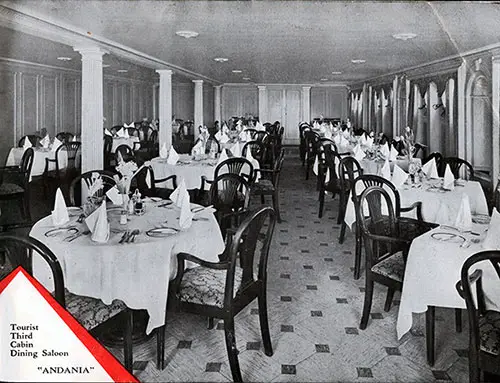
Tourist Third Cabin Dining Saloon on the Andania. Cunard Tourist Third Cabin Accommodations, 1920s. | GGA Image ID # 11951b88b0
Return to Content Links
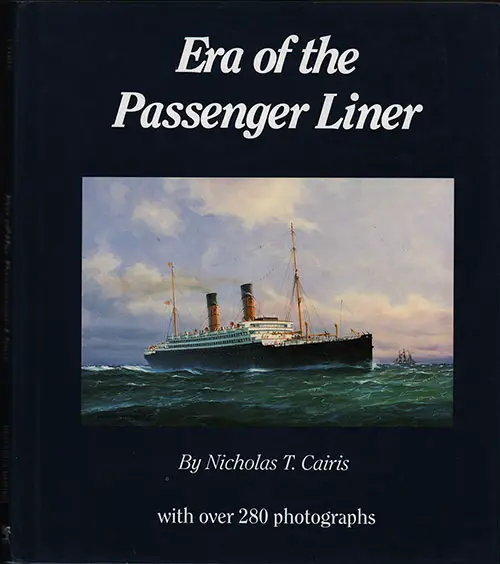
Era of the Passenger Liner - 1992
The Gilded Era comes back to life as the reader relives the careers of stately ships and express greyhounds from immigrant ships to floating palaces. Scarce, large format book containing 288pp. Features photographs, statistics, and background of 280 passenger liners, each with a picture.
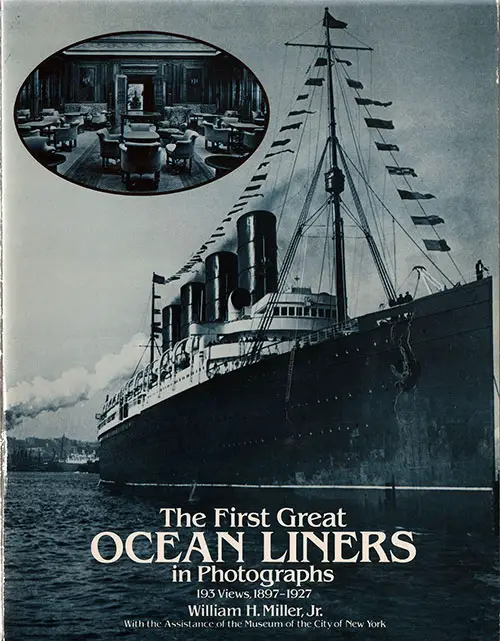
The First Great Ocean Liners in Photographs - 1983
Sumptuous volume recalls the glorious early years of elegant transatlantic travel. Over 190 historic photographs depict exterior and interior views of 101 great ocean liners, including the Virginian, Imperator, Vaterland, Bismarck, Lusitania, Mauretania, Balmoral Castle, Titanic, Olympic, Aquitania and dozens more. Full captions.
Return to Content Links
The Sinking of the SS Andania, 1918
On January 27th, 1918, the Andania was torpedoed without warning, having sailed the day previously from Liverpool via the North of Ireland with 51 passengers and mail.
Captain J. Marshall, in command, immediately ordered her boats to be lowered with the result that within a quarter of an hour, all the passengers and crew were clear of the ship, except the Captain himself, the Chief, First, Second, and Third Officers, who made a special request to the Captain to be allowed to remain on board.
How the boats were thus speedily lowered and filled and navigated to positions of safety was an evolution that reflected favorably on the ship's organization. Captain Marshall then examined the vessel and called for volunteers from the nearest boat.
The response was immediate and unanimous, and the Chief Engineer, Purser, Wireless Operator, and two Stewards, with two Able Seamen at once, returned on board with an acceptable carelessness to their safety and rendered valuable assistance in getting out hawsers forward and aft.
At half-past two, these men were again ordered to leave the vessel and, with the occupants of the other boats, were picked up by patrols. Captain Marshall and his Chief Officer (Mr. Murdoch) boarded a drifter.
They stood by the Andania until 4 p.m., when they again returned on board to make her fast to a tug that had just arrived, still entertaining the hope that it might be possible to save her.
Unhappily, their efforts were of no avail, the vessel sinking about half-past seven. Seven lives were unfortunately lost, probably as a result of the explosion.
Archibald Hurd, A Merchant Fleet at War, London-New York-Toronto-Melbourne: Cassell and Company, Ltd., 1920, pp. 41-42.
New Cunarder Successfully Launched - 1921
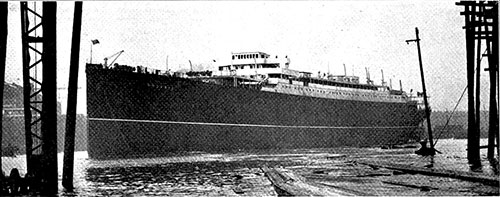
The New Oil Burning Cunarder Andania. | GGA Image ID # 142047040d
The new oil-burner Andania, the seventh Cunard steamer built since the war, is intended for the Canadian service.
THE Andania, launched recently by Lady Perley, wife of Sir George Perley, K.C.M.G., High Commissioner for Canada, has been built by Hawthorne, Leslie & Company, at Hebburn-on-Tyne.
Her dimensions are Length overall, 540 ft.; beam, 65 ft.; depth, 43 ft.; tonnage, 14,000; speed, 16 knots; and accommodation for passengers, cabin 500, third class 1,200.
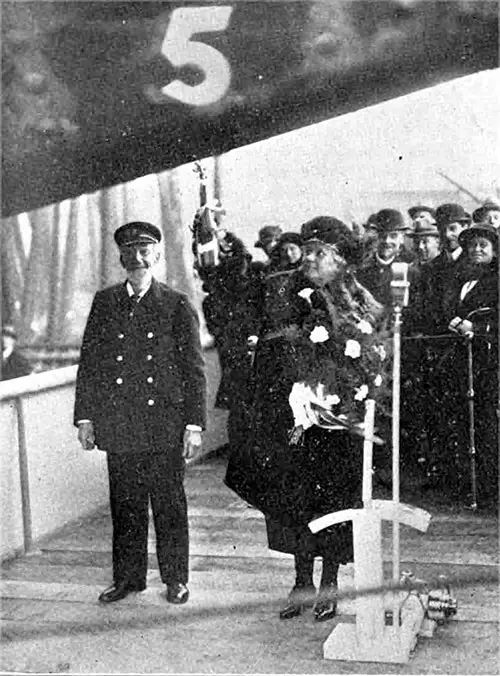
Lady Perley Christening the Andania. | GGA Image ID # 142078259f
The Andania, the seventh vessel in the Cunard post-war building program, is set to join the ranks of the Scythia and Albania, two ships that have already been commissioned. This program is a testament to Cunard's commitment to maritime innovation and service excellence.
The Andania, too, is one of six ships of her type, which will carry only cabin and third-class passengers. She has been designed specially for the Cunard Canadian service, and she is expected to take her place in this service during the Spring.
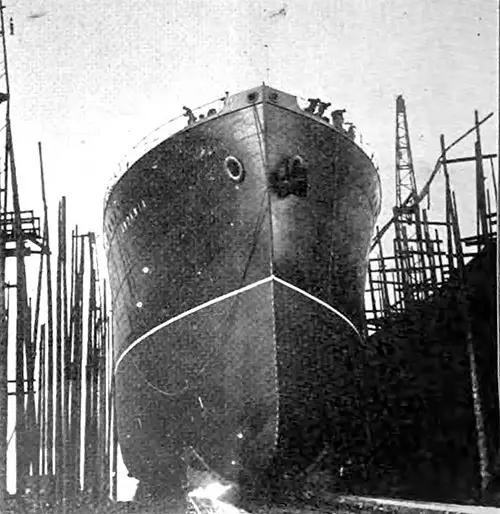
The Andania Sliding Down the Slipway to the River Tyne. | GGA Image ID # 1420ddc155
Cabin Passenger Accommodation
The public rooms have been designed by Shepheard & Bower, architects of Liverpool.
Cabin Class Saloon
The saloon, a testament to elegance, will be treated in a refined Colonial Adams manner. The portholes, arranged in groups of three, will be enclosed within architraves, creating a pleasing effect enhanced by the draw curtains.
The saloon will be a visual delight, with a color scheme that evokes a sense of elegance and grandeur. The shades of ivory white, complemented by rich blue curtains and gold trimmings, will create a striking contrast, enhancing the overall aesthetic appeal of the space.
The saloon will feature fine Spanish mahogany furniture, a perfect harmony with the overall decorative scheme. The furniture will be thoughtfully arranged in groups of small tables, accommodating two, four, or six persons each. To ensure flexibility, independent chairs will also be provided, allowing for easy reconfiguration of the seating arrangement.
The center portion of the saloon is carried up into the deck above, forming a central dome with a musicians' gallery on one side and, on the other side, the main staircase landing. The other two sides of the dome will be enriched with semi-circular-shaped fresco paintings in tempera.
Staircase
The main staircase leads from the end of the saloon and, passing through intermediate decks, giving access to passengers' staterooms, etc., terminates in the writing room on "A" deck.
The staircase is planned on handsome lines and rises easily in short flights. It has a wide central flight and two return flights to each deck. The stairway is of the open type and has a continuous wreathed handrail supported on elegant wrought iron balusters.
Extending from the "D" deck to the "A" deck, the staircase, paneled throughout, is a very handsome feature of the ship.
"A" Deck
"A" Deck is the promenade deck and a delightful suite of entertaining rooms, comprising a writing room, lounge, smoke room, and verandah cafe, occupying all the available space on this deck.
These rooms are all lighted by large sash windows sheltered by the boat deck, through which the view to the sea is gained across the promenade deck.
The center portions of these rooms are carried up several feet above the boat deck, giving them added height and Importance and allowing a pleasing effect of clerestory lighting by means of decorative lunettes.
Cabin Class Writing Room
This room will serve as the drawing room of the ship and is designed in the style of R. & J. Adam. The color scheme will be in shades of French grey with curtains in old gold and blue trimmings.
The furniture will be arranged in groups of small tables for writing, occasional tables, and settees, harmonizing in color and designed in keeping with the general treatment of the room.
Cabin Class Lounge
The architectural treatment of the lounge will have French influence in the detail and enrichment. The color scheme will be in shades of lavender. The touch of warmth in the color of the old rose silk curtains, and upholstery will give a note of comfort to the general scheme. This room will have an open fireplace in a comfortable recess in the center at the forward end.
Cabin Class Smoking Room
This room will be finished in walnut, with the walls paneled in this material throughout. It is designed in the Colonial Adams style, which is quiet and restrained.
Paneled pilasters, carried up to the full height of the ceiling, having dull gilt capitals and delicate enrichment on the upper part of their panels, combined with the ceiling beams also in walnut, will give a sense of dignity and repose to the general decoration scheme.
At the forward end of the room, a fireplace is arranged in a recess forming an angle, and it is provided with an open electric fire and a handsome marble chimneypiece designed to keep with style.
At the end, a similar recess forms a bay window treatment, the large window of which gives a pleasant outlook on the verandah café. The window hangings will be in green and dull gold, and the furniture will consist of large settees and easy chairs upholstered in leather, harmonizing in color.
The tables will be walnut, designed to accord with the general scheme. This furniture is independent, and with chairs and settees arranged in groups at separate tables, all the amenities and comfort of a first-class club smoke room will be obtained.
Verandah Café
The verandah café is approached directly from the promenade deck and the smoke room. The café is carried out in a simple treatment of French treillage, consisting of paneled walls and pilasters.
The fascination of the stern view has not been overlooked, and passengers seated in the café benefit from this through the large central window, the two side windows, and the two large openings looking directly astern.
The two large openings can be closed by sliding doors for protection against bad weather. The furniture will consist of wicker chairs and tables arranged in groups around the windows, giving the passengers the full benefit of the view of Bea.
With the delicate green treillage on a cream background, a charming open-air effect will be obtained, and because of the cafe’s sheltered position, it will undoubtedly prove a very favorite resort.
Children’s Room
Paneling the room, breast high, with sycamore, polished its natural ivory tint, and severe moldings and simple enrichments dyed a bright red has given it an effect of cheerful cleanliness.
A continuous frieze illustrates the principal incidents from “Alice in Wonderland,” and the windows are glazed with old-fashioned “Bull’s Eye” panes, which are fascinating to children.
Two cozy inglenooks with comfortable seats have been built. The frieze on the three sides is painted with a large tree whose branches extend over the cove and entwine on the ceiling. The effect is that of a garden arbor where the youngsters can have their “make-believe” alfresco tea.
Both the floor and ceiling have been converted into sources of interest and amusement. The former is provided with an inlaid animal border, while the center portion is inlaid with the necessary outlines for “hopscotch,” “shuffleboard,” “marbles,” etc. The latter is painted sky-blue and sprinkled with silver stars; the lighting is obtained through the conventional cheery-faced sun and the man on the moon.
The paneling incorporates a large slate with a fitting for colored chalks, and a small library of favorite children’s books is provided.
The miniature furniture is comfortable and designed with hygiene in mind. White enameled, decorated with bright colors, and with all awkward corners eliminated, it will delight most children who love to discover articles of their own scale.
The Kitchens
The provision of a steady sea-going ship and luxurious public rooms and staterooms is not enough to ensure the comfort of passengers. One of the most important questions to be settled is that of catering. On the Andania, particular attention has been paid to the arrangement of the kitchens.
Our kitchens are not just any kitchens. They employ all the latest developments of the culinary art and are full of the most modern machinery and utensils, such as ranges, stockpots, steam ovens, mincing, slicing, potato peeling, dough mixing machines, hot presses, bain-maries, electric toasters, and dishwashing machines. We've spared no expense in ensuring that our guests experience the pinnacle of modern luxury.
Electricity plays a great part in these kitchens, and the application of science, with its latest discoveries and inventions, will ensure the enjoyment of a meal on the Andania, even for the most fastidious travelers.
Third Class Accommodation
Third-class passengers will find that the Andania has given every attention to their comfort. The public rooms are unusually spacious. The dining saloon is large and airy, and the special kitchens, fitted with every modern, up-to-date culinary device, ensure that not only is the cooking excellent but also that the service is speedy.
The smoking room, general room, and public room have all been designed to cater to the special needs of those who frequent them. They are well-lighted and well-ventilated.
The cabins are commodious and have berths for two or four passengers. The third-class passenger will find that the appointments in these rooms are complete.
Comfortable mattresses, counterpanes, sheets, and pillows are provided, and the toilet arrangements ensure the greatest comfort to the traveler. The rooms are separated by spacious alleyways, and there is an atmosphere of airiness and lightness about the whole of these quarters.
Promenade space, both open and covered, has not been forgotten. Indeed, the whole scheme of accommodation for third-class passengers reaches a height of perfection that has certainly never been excelled in any other ship.
Propelling Machinery and Boilers
General Description
The propelling machinery consists of steam turbines of the Parsons type driving twin screws through double reduction mechanical gearing. The central machinery consists of two sets of turbines and mechanical gearing, generally by the latest practice for superheated steam and suitable for a working pressure of 220 lbs. per square inch.
The ahead propelling machinery of each set consists of one high-pressure turbine driving through a flexible coupling in one pinion, one low-pressure turbine driving through a flexible coupling in the other pinion of the first reduction gearing, and through the second reduction pinions to the gear wheel mounted on the main shaft.
The astern propelling turbines are incorporated in the same casings as the low-pressure ahead turbines. The total power for astern work is about 63 percent of the ahead power.
The complete turbine Installation can develop a collective shaft horse-power of about 8,600, with the propeller shafts turning at about 90 revolutions per minute. Steam is supplied by two double-ended and two single-ended cylindrical annul-tubular boilers arranged in one ship compartment.
The boilers are arranged for burning oil fuel, but provision is made for fitting coal-burning furnace mountings. Smoke tube superheaters are fitted to the boilers.
Turbines
The h.p. turbine is designed for 3,190 revolutions per minute, and the l.p. turbine for 2,170 revolutions. The h.p. turbine rotors are of forged steel of the solid type. The l.p. turbine rotors have a series of discs of forged steel driven onto a forged steel spindle and put together to ensure rigidity under all working conditions.
The mechanical reduction gearing is of the double helical type. The main shafting throughout is of hydraulic forged ingot steel. The propeller shafts are forged of ingot steel turned all over and covered in the way of stern tubes with brass liners.
The two propellers are 18 ft. in diameter. The forced lubrication oil system is fitted completely to supply port and starboard engines.
The condensers are suspended from the underside of the l.p. turbines, each with a cooling surface of 4,260 square feet. The auxiliary machinery includes two centrifugal-type circulating pumps, each driven by a horizontal spindle steam turbine, one turbo-driven, two direct-acting feed pumps, two turbo water extractor pumps, and other fittings in connection with the Vickers closed feed system.
There are three D.A. forced lubrication pumps, two ballast pumps, two bilge pumps, two 50-tone evaporators, two F.W. pumps, two turbo generators, an auxiliary circulating pump, and a small condensing and pumping plant for dealing with steam drains.
An auxiliary condenser with a cooling surface of about 1,000 square feet has been installed in the engine room. All the turbo-driven auxiliary machinery is suitable for using superheated steam.
Boilers
The mean diameter of all the boilers is 17 ft. 6 in. The mean length of the double-ended boilers is 22 ft. 6 in., and of the single-ended boilers is 11 ft. 6 in. Each double-ended boiler has eight furnaces, and each single-ended boiler has four furnaces.
The combined heating surface for the four boilers is about 19,900 square feet. The boilers are fitted with Robinson's type smoke tube superheaters capable of supplying steam haying a superheat of 200 deg. F. at the inlet to the h.p. turbine.
The furnaces are of the Morison suspension withdrawable type, each fitted with a separate combustion chamber. The boilers are arranged to burn oil on the White low-pressure system with Howden's forced draught.
The installation is arranged on the duplex system. It consists of two transfer pumps and two complete sets of pumping and heating plants, one of which acts as a stand-by. Settling tanks of suitable capacity are provided in the cross bunker between the engine and boiler rooms. A complete workshop is also provided for engineers' use.
Cunard Canadian Service
The forthcoming resumption of the direct Cunard Canadian service to Québec and Montréal recalls that the company's association with Canada dates back to its inauguration.
On her first sailing from Liverpool in 1840, the Britannia called at Halifax. For nineteen years, this call, both eastbound and westbound, was a regular feature of the company's Atlantic service. In 1859, however, the Halifax call was discontinued and was not resumed for over half a century.
In 1911, the Cunard company purchased three passenger steamers and ran them between London, Southampton, and Canada. These vessels were the Ascanla (10,000 tons), the Ausonla (8,000 tons), and the Albania.
One of the chief features of the company's Canadian service was that all ships were designed to carry only two classes of passengers—cabin and third class—an innovation that is being maintained in the resumed service.
The necessity also showed the tremendous success of the company's Canadian service for a rapid extension, and two new steamers, the Andania and Alaunia, were launched in early 1913.
These ships, each with a tonnage of 13,3é0| and 640 feet in length, had passenger accommodation that was notably ahead of previous ships.
Further, to assist Canadian travelers, personally conducted parties and special women's parties were arranged for all westbound sailings during 1913. In these, the services of experienced conductors were gratuitously provided to passengers.
In addition, an employment bureau was established in Toronto. This office, being in the closest touch with the labor situation in Canada, the Cun&rd officials who met the steamers at Québec could give valuable assistance to those who required situations.
The success of these vessels was indisputable, and when designing the new ships, the company had the advantage of experience already gained in addition to developments that had taken place in marine architecture and engineering since 1914.
In developing this class of vessel, they prove their intention of catering to travelers who require the highest degree of comfort at a moderate cost.
Unfortunately, the outbreak of war in 1914 ended for a time due to developments, and unluckily, every ship in the Canadian service was sunk while on war service, including the first Andania, whose name was given to the new ship.
As is generally known, after the Armistice, an immense building program was put into operation, and the needs of the Canadian service were not forgotten. Six big vessels, each 15,000 tons, were included in this program. All of them are designed to carry cabin and third-class passengers.
While awaiting the commissioning of these new ships, touch has not been lost with Canadian ports. Continually, some of the finest ships of the company's North Atlantic service have called at Halifax, notably the Caronia and Carmania, which have been the largest vessels making regular use of the Canadian port.
Not only has there been continuous service between the British Isles and Halifax, but regularly during the season, Cunard freighters have sailed to and from the St. Lawrence.
Like all the new ships to take their place in the company's Canadian service, the Andania will be able to carry a large cargo in addition to a large number of passengers. She has space for some 10,500 tons of cargo.
Two new ships will be in service in early spring and sail directly to Québec. A month or so later, a third vessel will be placed in this service. At the same time, the call at Halifax will be maintained so that travelers will have the choice of numerous fine vessels.
Further developments are in view, and Canadian service is likely to play a very important part in Cunard's future program.
Cunard Fleet
At present, the Cunard fleet consists of twenty-four seagoing vessels. Eleven are still being built or completed. The Cunard company and its allied lines will soon control a tonnage approaching 1,000,000.
This immense fleet, serving as it will the chief ports of Europe, America, India, Australia, and New Zealand, will be a link in the overseas trade of the empire whose importance it will be difficult to overestimate.
It is of interest to note that two giant Cunarders are currently in the Tyne undergoing conversion to oil-fuel burners: the Berengaria at Armstrong, Whitworth & Company and the Mauretania at Swan, Hunter & Wigharn Richardson, Limited.
The Berengaria, with a tonnage of 52,000 and a length of well over 900 feet, is the biggest liner that has ever flown the red or blue ensign. The Mauretania, of 31,000 tons, with a length of 788 feet, holds all the speed records of the Atlantic.
The Berengaria is the largest ship to have successfully navigated the Tyne, a distinction held until recently by the Cunarder Aquitania, which was in the Tyne for the same purpose last year.
As soon as the conversion of the Berengaria and Mauretania is completed, they will return to the Cunard express service between Southampton, Cherbourg, and New York. Together with the Aquitania, they will form the fastest passenger and mail ocean service in the world.
Tyneside is particularly delighted that the task of converting the Mauretania has fallen to it, as she was built at Swan, Hunter & Wigharn Richardson’s with the express intention of capturing the Blue Riband of the Atlantic again for Britain.
"New Cunarder Successfully Launched," in Shipping, Marine Transportation, Construction, Equipment, and Supplies, New York: Shipping Publishing Company, Inc., Vol. XIV, No. 12, 25 December 1921, p. 7-10
The Andania Public Rooms Architecture - 1922
After the war's conclusion, the Cunard Line embarked on an extensive shipbuilding program. The "Andania" is the fifth of the new ships in this program to be commissioned. It is one of the six ships of its type that will carry only cabin and third-class passengers. The accompanying illustrations show some of the more critical accommodations for the cabin passengers.
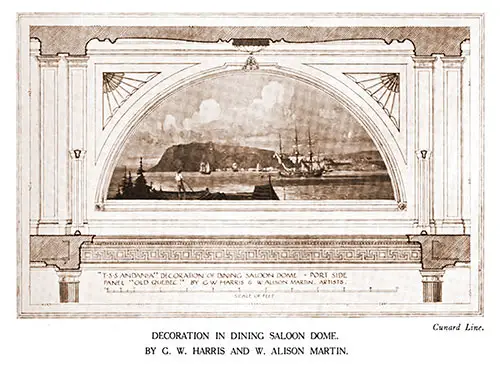
Decoration in Dining Saloon Dome of the Andania. Shepheard and Bower, F. and A.R.I.B.A., Architects. | GGA Image ID # 1f8f61d59c
The saloon adjoins the kitchen department, from which it obtains immediate service. It is treated in a Colonial Adam manner. The portholes are arranged in groups of three. Each group is enclosed within one architrave, behind which drawn curtains are hung, thus producing the effect of a series of large windows extending from the floor to the ceiling. The color scheme is in shades of ivory white, with rich blue curtains and gold trimmings.
The Spanish mahogany furniture is treated in harmony with the decorative scheme. Small tables have been arranged to accommodate two, four, or six persons, and independent chairs are also provided. The center portion of the saloon is carried up into the deck above, forming a central dome, with a musicians' gallery on one side and the main staircase landing on the other.
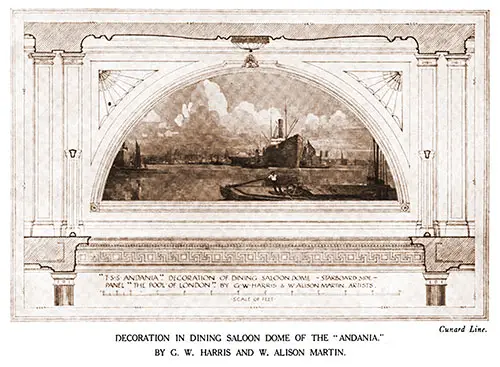
Decoration in the Dining Saloon Dome of the RMS Andania. Shepheard and Bower, F. and A.R.I.B.A., Architects. | GGA Image ID # 1f8f6af860
The other two sides of the dome are enriched with semi-circular-shaped fresco paintings in tempera. The architects commissioned Mr. G. W. Harris and Mr. W. Alison Martin, two Liverpool artists, to carry out these paintings.
The main staircase leads from the after-end of the saloon, passes through intermediate decks, which give access to the passengers' staterooms, etc., and terminates in the writing room.
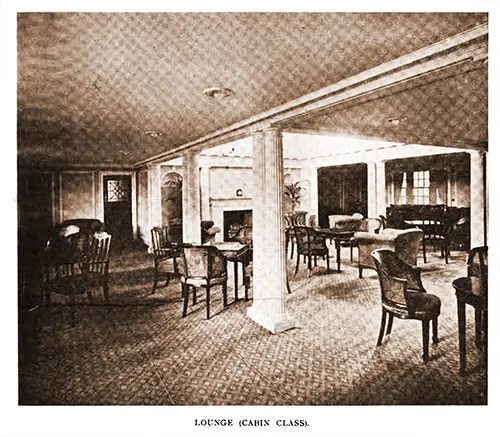
Cabin Class Lounge on the RMS Andania. | GGA Image ID # 1f8fa5fdb7
The staircase rises quickly in short flights and has a wide central and two return flights to each deck. The stairway is of the open type and has a continuous wreathed handrail supported on elegant wrought-iron balusters. The staircase paneling forms a very handsome feature of the ship.
On the promenade deck is a suite of entertaining rooms comprising a writing room, lounge, smoke room, and a veranda cafe. These rooms occupy all of the available space on this deck. They are all lighted by large sash windows, sheltered by the boat deck, and through which the view to the sea is gained across the promenade deck.
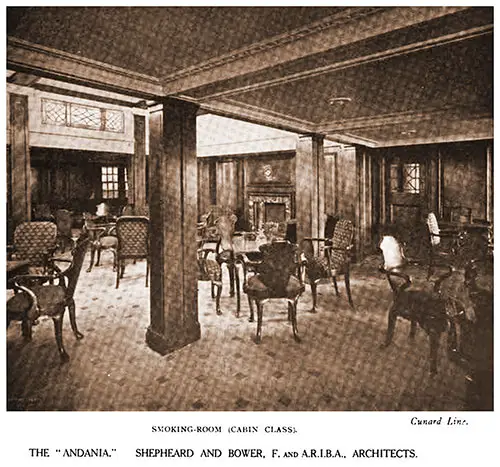
Cabin Class Smoking Room on the Andania. Shepheard and Bower, F. and A.R.I.B.A., Architects. | GGA Image ID # 1f8fd9e277
The center portions of these rooms are carried up several feet above the boat deck to give them added height and importance and to allow decorative lunettes to achieve a pleasing effect of clerestory lighting.
Although the writing room is designed in a style that is in keeping with the saloon, its detail is more delicate, as it serves as the drawing room of the ship. A fireplace is provided at the forward end of the room. The color scheme is in shades of French grey, with curtains in old gold and blue trimmings.
Groups of small tables are arranged for writing, and occasional tables and settees, harmonizing in color and designed to be in keeping with the general treatment of the room, are provided.
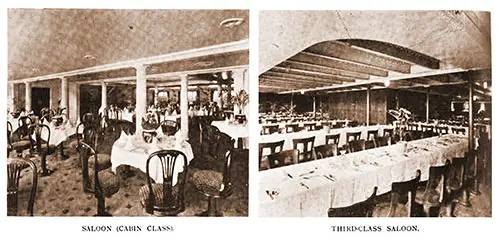
Cabin Class Saloon and Third Class Saloon on the RMS Andania. | GGA Image ID # 1f8fec9853
The architectural treatment of the lounge shows a French influence in the detail and enrichment. The color scheme is in shades of lavender, and the touch of warmth in the color of the old rose silk curtains and the upholstery gives the lounge a feeling of comfort. An open fireplace is provided in a comfortable recess in the center of the room at the forward end.
The smoking room is made of oak, and the walls are paneled in this material; although kept in harmony with the other rooms, more Florentine influence has been introduced into its design. The paneled pilasters carried up to the ceiling have dull gilt capitals; the delicate enrichment on the upper part of the panels and the oak ceiling beams give a sense of dignity and repose to the general decoration scheme.
In the recess forming an angle, a fireplace has been arranged at the forward end of the room, furnished with an open electric fire. At the end, a similar recess forms a bay window, giving a pleasant outlook on the veranda cafe.
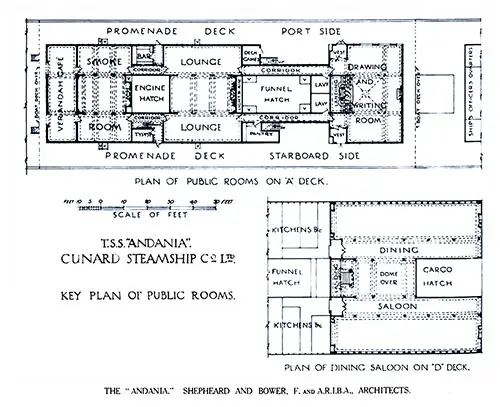
Key Plan of Public Rooms on the RMS Andania. Shepheard and Bower, F. and A.R.I.B.A., Architects. | GGA Image ID # 1f8ff609b5
The window hangings are in green and dull gold, and the furniture, consisting of large settees and easy chairs, is upholstered in leather and harmonizes in color with the decoration scheme. The furniture is independent, and the chairs and sofas are arranged in groups at separate tables. In this manner, all the amenities and comfort of a first-class smoke room are obtained.
The veranda cafe is approached directly from the promenade deck and the smoke room. It is constructed in a simple French treillage consisting of paneled walls and pilasters.
The fascination of the stern view has been noticed, and passengers seated in the café benefit from this through the large central window, the two side windows, and the two large openings looking directly astern.
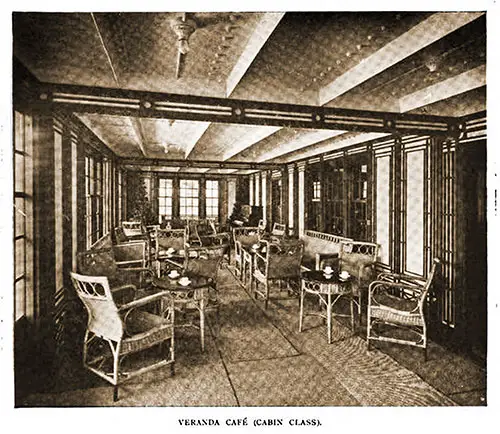
Cabin Class Verandah Café on the Andania. | GGA Image ID # 1f90684550
The two large openings can be closed by sliding doors for protection against bad weather. Wicker chairs and tables are arranged in groups around the windows to give passengers the full benefit of the view of the sea. The delicate treillage and the cream background give a charming open-air effect, and the cafe's sheltered position makes it a favorite resort.
The furnishing department of the Cunard Company designed the children's room throughout. It is paneled with sycamore, polished to its natural ivory tint, and the moldings and enrichments are bright red.
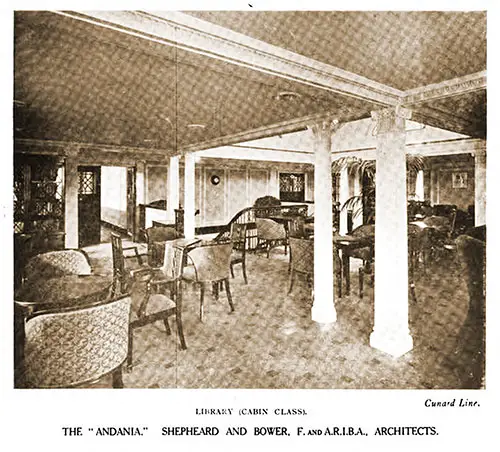
Cabin Class Library on the RMS Andania. Shepheard and Bower, F. and A.R.I.B.A., Architects. | GGA Image ID # 1f908cac97
A continuous frieze illustrates the principal incidents from "Alice in Wonderland." Two inglenooks with seats have been built. The frieze on the three sides of the frieze is painted with a large tree, whose branches extend over the cove and entwine on the ceiling.
The effect gained is that of a garden arbor where the youngsters can have their "make-believe" alfresco tea. Both the floor and the ceiling have been converted into sources of amusement and interest.
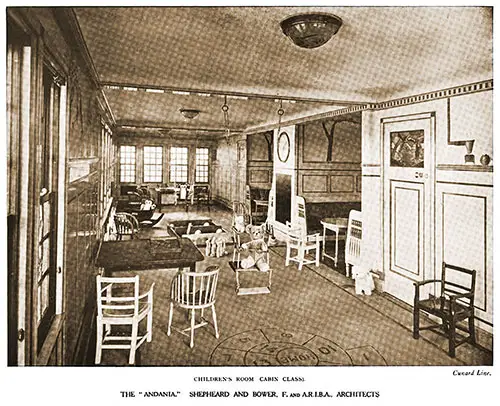
Cabin Class Children's Room on the RMS Andania. Shepheard and Bower, F. and A.R.I.B.A., Architects. | GGA Image ID # 1f8f384002
The former is provided with an inlaid border of animals, the center portion being inlaid with the outlines for "Hop Scotch," "Shuffle Board," "Marbles," and other games.
The ceiling is painted sky-blue and sprinkled with silver stars, and the lighting is obtained through the conventional cheery-faced sun and the "Man in the Moon." A large slate with a fitment for colored chalks has been incorporated in the paneling, and a small library of children's favorite books is provided.
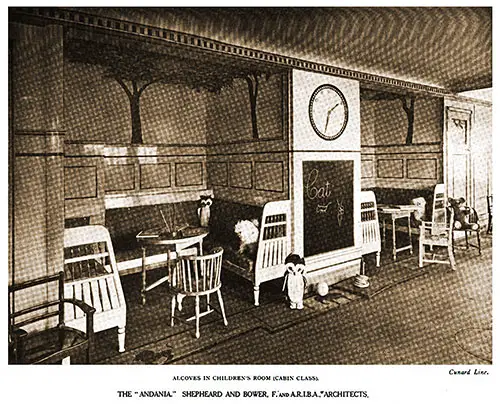
Cabin Class Children's Room Alcoves on the RMS Andania. Shepheard and Bower, F. and A.R.I.B.A., Architects. | GGA Image ID # 1f8f2fb72b
The miniature furniture is comfortable and designed with an eye to hygiene—it is white enameled, decorated with bright colors, and has all awkward corners eliminated. It delights most children, who love to discover articles of their own.
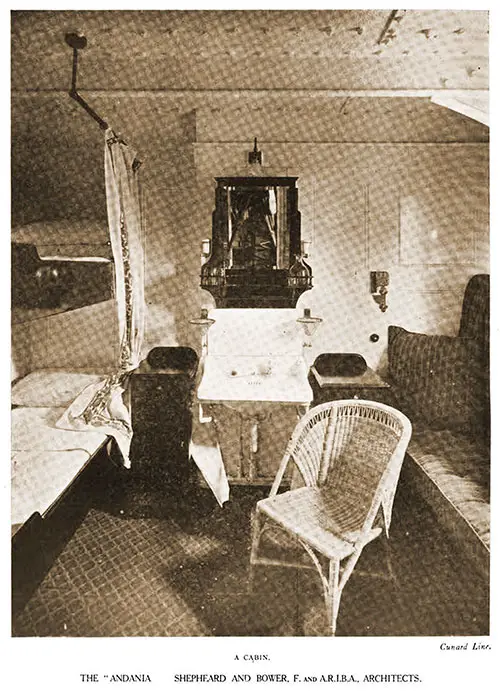
A Cabin or Stateroom on the Andania. Shepheard and Bower, F. and A.R.I.B.A., Architects. | GGA Image ID # 1f8f2a940c
The general contractors, the esteemed Messrs. Gillow & Co. (Waring and Gillow, Ltd.), Lancaster, were not only responsible for the entire woodwork in the public rooms but also brought their unparalleled expertise to the project.
The sub-contractors, each a master in their respective fields, contributed their unique skills to the project. E. A. Clarke, Ltd., Liverpool (fire grates); G. Jackson and Sons (mantels and plasterwork); Thos. Elsley, Ltd. (metal lunettes in public rooms); The Kingsmill Art Metal and Electric Co., London (metalwork and wrought-iron balusters); Guiggin Bros., Liverpool (door furniture, locks, etc.); John Stubbs and Sons, Liverpool (marble work in fireplaces); Gent & Co., Leicester (synchronized clocks); Messrs. G. W. Harris and W. Alison Martin, Liverpool (wall paintings); The Cunard Furnishing Department, Liverpool (furnishing). Electric "magicoal" fires, by Messrs. Berry, are fitted throughout.
SHEPHEARD and BOWER, F. and A.R.I.B.A., Architects, "The Andania," in The Architects' Journal: The Architectural Decoration of Ships Special Issue, Volume LVI, No. 1451, Wednesday, 25 October 1922, pp. 575-582.
Return to Content Links
R. & W. Hawthorn, Leslie & Co., Ltd., Hebburn-on-Tyne.
Twin-screw passenger and cargo steamer" Andania." of the intermediate type; 540 ft. overall, by 65 ft by 43 ft.; 14,000 tons gross; 15 knots' speed. The vessel is the seventh to be launched of the ships in the Cunard Steamship Company's post-war building program. Two of these— the Scythia and Albania are already in commission. The Andania, too, is one of six ships of her type, carrying only cabin and third-class passengers.
Designed especially for the Cunard Company's Canadian service, she is expected to take up her service in the spring. Accommodation is provided for 500 cabin class and 1,200 third-class passengers.
The saloon for cabin passengers is situated on the "D" deck. The main staircase leads from after the end of the saloon and, passing through the intermediate decks and giving access to the staterooms, etc., terminates in the writing room on "A" deck.
On the "A" deck are a writing room, lounge, smoking room, and verandah café. A children's room is also provided. For third-class passengers, the public spaces are unusually spacious and comprise a dining saloon, smoking room, general room, etc. The third-class cabins are fitted for two and four passengers.
The propelling machinery, constructed by the shipbuilding company at their St. Peter's Works, Newcastle, consists of two sets of Parsons turbines driving twin screws through double-reduction mechanical gearing and arranged to take superheated steam at 220 lbs pressure. The ahead propelling machinery of each set comprises one h.-p. Turbine driving through a flexible coupling, one pinion, and one l.-p. Turbine driving through a flexible coupling the other pinion of the first-reduction gearing and the second-reduction pinions to the gear-wheel mounted on the main shaft.
The astern turbines are incorporated in the same casings as the l.-p. Ahead turbines. The total power for astern work is about 63 percent of the ahead power. The complete installation can develop a collective S.H.P. of about 8,500 with the revolutions of the propeller shafts at about 90 per minute.
The h.-p. Turbines are designed for 3,190 RPM. and the 1.-p. Turbines for 2,170 revs. Steam is supplied by two double-ended and two single-ended boilers placed in one compartment of the ship.
The boilers are arranged to burn oil fuel on the White low-pressure system. Provisions have also been made for fitting coal-burning furnace mountings. Howden's forced draught system is installed, and the superheaters are of Robinson's smoke-tube type. It launched on 1 November 1921.
"Launches and Trial Trips," in The Shipbuilder, Vol. XXV, No. 136, December 1921, pp. 357-358.
Return to Content Links
